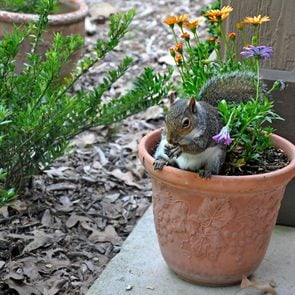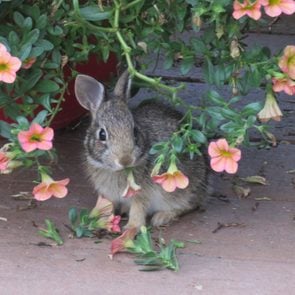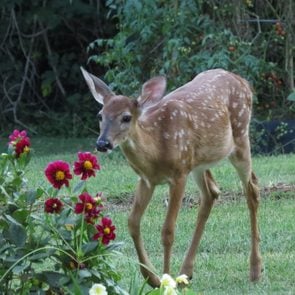On This Page
Why You Need a Perennial Garden
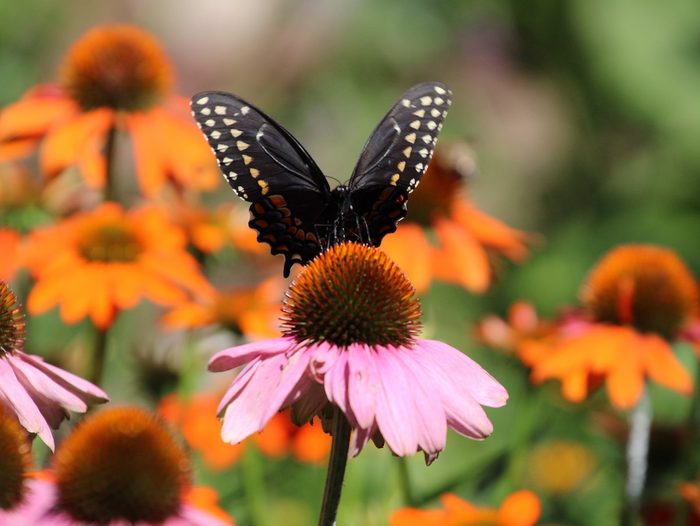
Plant once, enjoy for many years—that’s one of the top reasons to plant a perennial garden. Beyond adding color and interest, perennials stay in the ground over time, which means their extensive root systems will help hold soil in place, reducing the risk of soil erosion.
You can also save time and money by planting low-maintenance varieties and dividing them as they mature to make new (and free!) plants, says garden designer and author Kerry Ann Mendez, owner of Perennially Yours in Kennebunk, Maine. “My passion is working with perennials, especially shade perennials,” Kerry Ann says. “I love that you don’t have to keep planting them every year.”
Choosing Perennial Plants: Do Your Homework
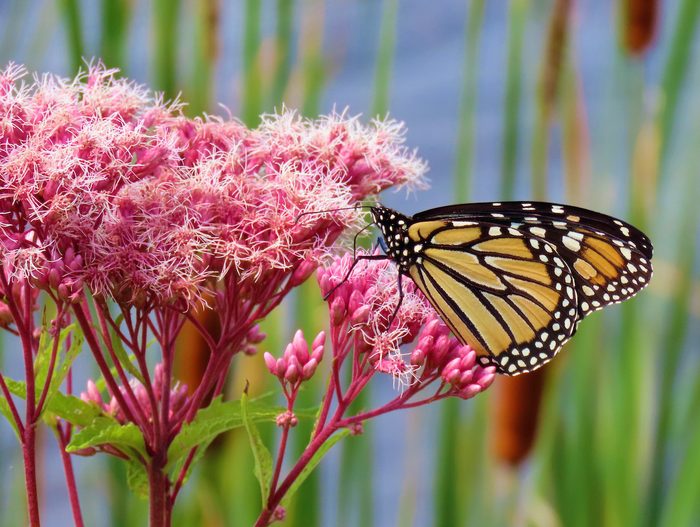
Know your hardiness zone before picking perennials. Also consider your summer heat, humidity, soil and drainage conditions, and opt for native plant species. “Smart plant selection and putting them in the right location brings great satisfaction with less work, and they’re going to benefit the ecosystem,” Kerry Ann says. “Look for plants that are more drought tolerant, like coneflowers, nepeta, lavender and sedum.”
Perennials also provide food and shelter for bees, butterflies and birds. In addition to planting pollinator-friendly plants, Kerry Ann suggests choosing varieties that provide nectar and pollen. “We also need host plants for butterflies and moths to lay their eggs on, and for caterpillars,” she says. “Try goldenrod, asters, milkweed and sunflowers.”
Remember to check for invasiveness of specific plants within your own region, adds Kerry Ann. “I love bee balm, but I’m always cautious with it and other plants that may look cute in containers at garden centers but can spread aggressively,” she says, also mentioning gooseneck loosestrife, yellow evening primrose, Pink Octopus bellflower and obedient plant as ones to keep an eye on.
Grow the best year-round perennials for interest regardless of the season.
Perennial Garden Advice: Divide Plants
Gardeners often divide spring bloomers in fall, and summer or fall bloomers in the spring, but Kerry Ann suggests that those in Zones 6 or colder divide spring bloomers right after they finish flowering. “Shear off the blooms and divide them then so they have months to set those roots and anchor in well,” she says. “The following spring, they’ll be in much better condition to give us a glorious show.”
With varieties that get woodier in the root, such as coral bells, Kerry Ann suggests digging out the plant and turning it on its side to get a clear view of its root system, and making a clean slice. “If you can get a number of stems and a good chunk of root, that’s fine,” she says. “Then, plant that piece deeper than it was so they flush out and come in beautifully.”
Don’t make common perennial plant mistakes.
Perennial Garden Plants for Sun
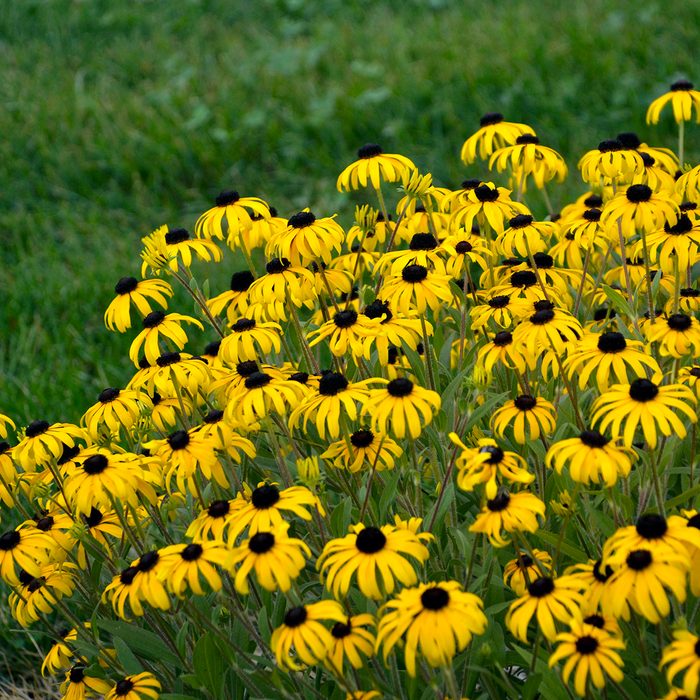
American Gold Rush Black-eyed Susan
Rudbeckia
With vibrant yellow flowers that bloom right up until fall, this black-eyed Susan variety also has hairy silvery foliage that glistens in the sun. Even better, it is resistant to Septoria leaf spot.
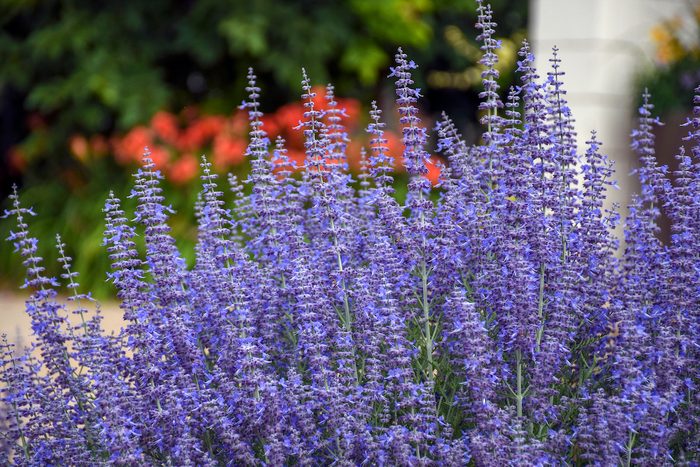
Denim ’n Lace or Sage Advice Russian Sage
Perovskia atriplicifolia
These drought-tolerant, heat-resistant herbaceous woody varieties of Russian sage boast lavender-purple blossoms and silvery green leaves that attract hummingbirds, butterflies and bees.
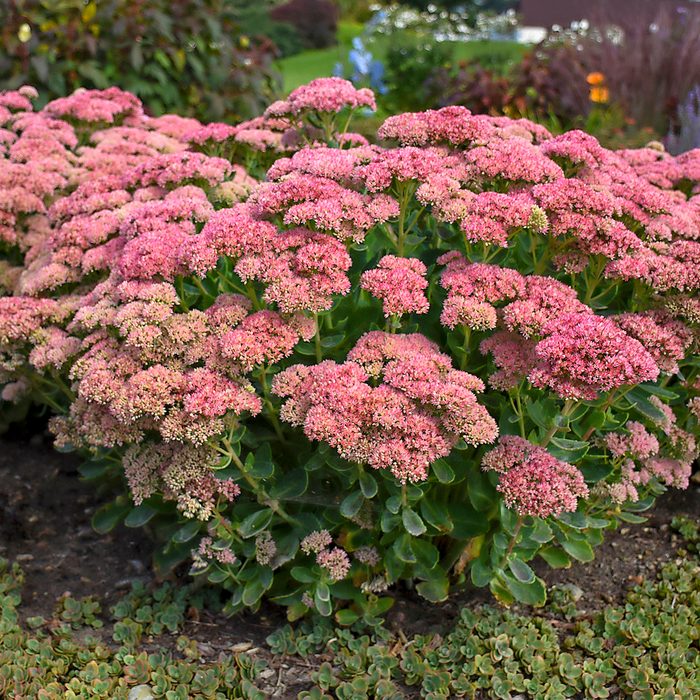
Autumn Joy Sedum
Hylotelephium ‘Herbstfreude’
Hardy clumps of foliage produce huge flowerheads that provide great color in the fall, plus a food source for birds during winter. Check out our ultimate sedum plant guide.
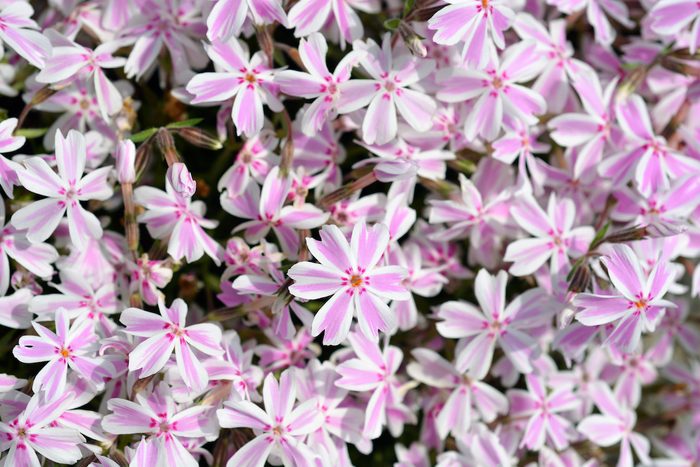
Candy Stripe Creeping Phlox
Phlox subulata
Featuring gorgeous, star-shaped crimson-and-white flowers beginning in midspring, this compact creeping phlox variety will last for years.
These are the 10 perennials you should cut back in fall (and five you should leave alone).
Perennial Garden Plants for Shade
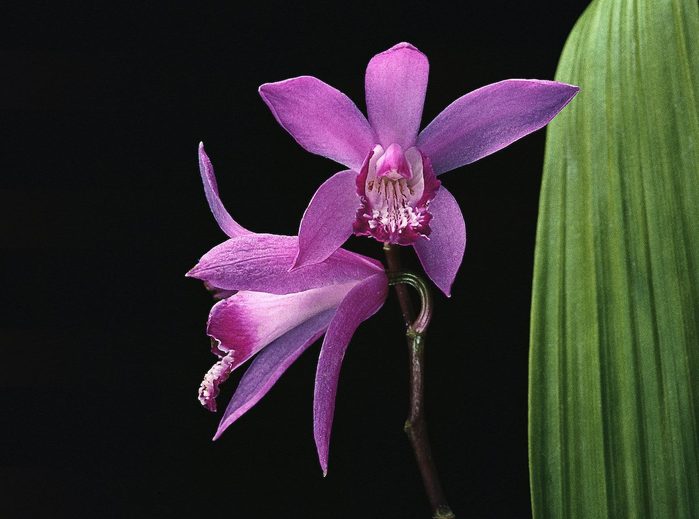
Candle in the Wind Orchid
Bletilla
These orchids burst into life in spring and summer in shades from white to pink, forming a hardy, dense clump with stunning spikes.
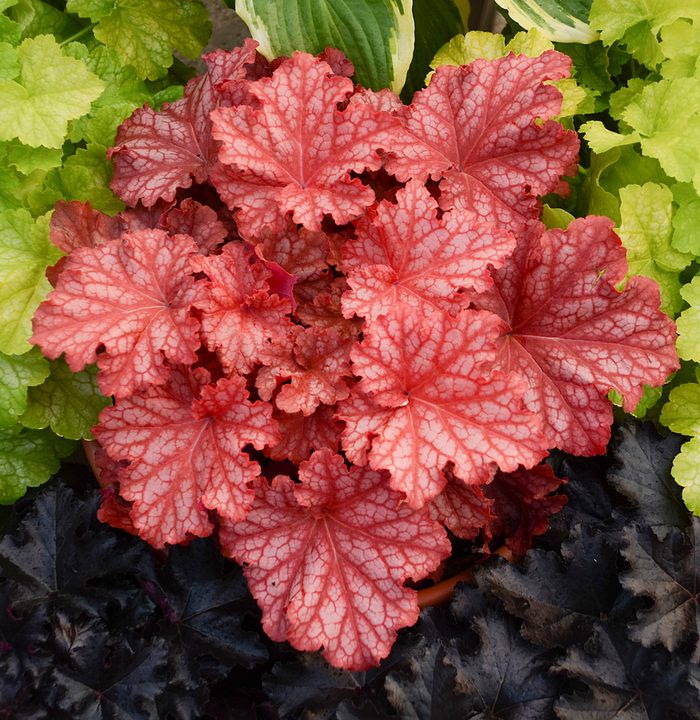
Primo Peachberry Ice Coral Bells
Heuchera hybrid
An explosion of orange leaves is sure to liven up a shade garden, and this variety has ruffled foliage with hot pink undersides and cream-colored flowers.
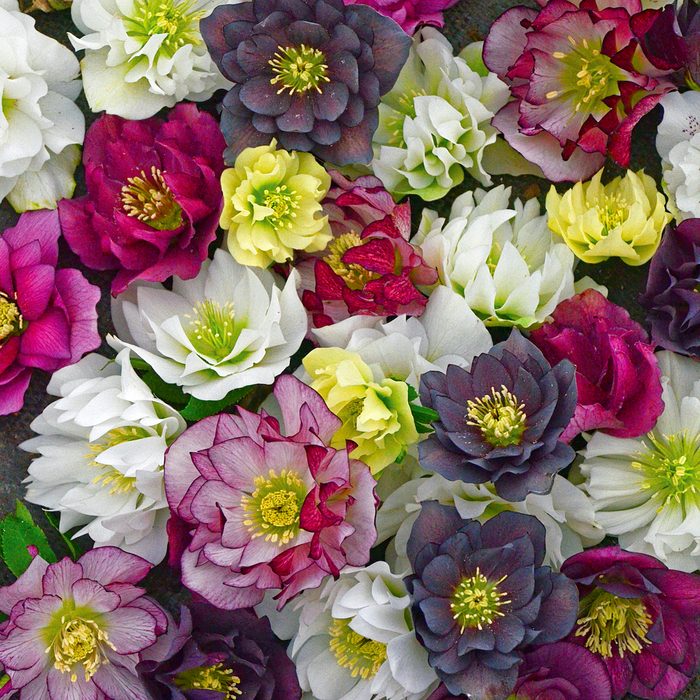
Wedding Party Mix Hellebores
Helleborus
Producing lovely double blossoms in late winter and early spring, these deer-resistant blooms pack a jolt of pink, yellow, black, white and purple when the garden needs color the most.
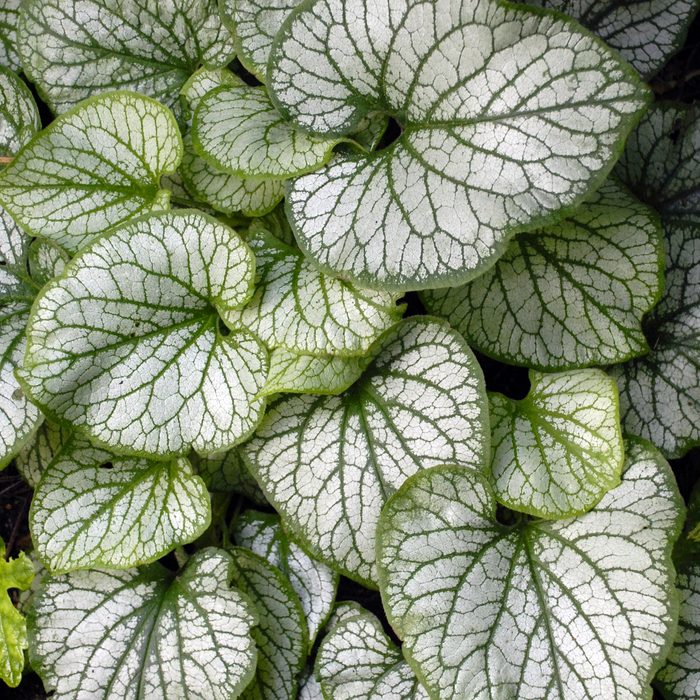
Jack Frost Siberian Bugloss
Brunnera macrophylla
This striking ornamental plant has delicate silver variegated foliage, often resembling a heart, and tiny bright blue flowers that bloom in early spring.
Perennial Garden Plants for Wildlife
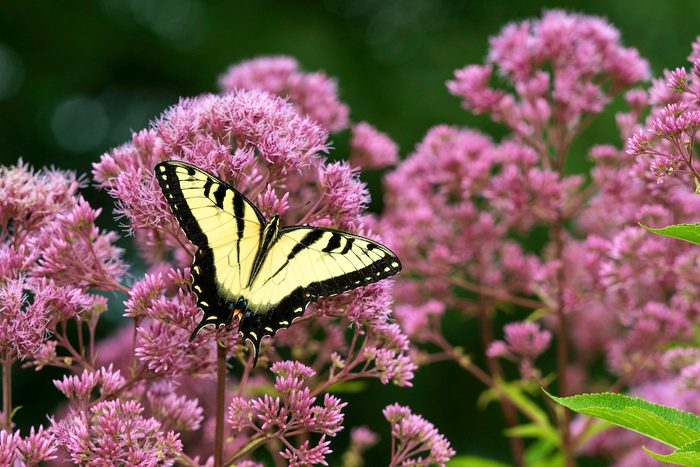
Joe Pye Weed
Eutrochium purpureum
Bracts of purple-pink blooms produce dense clusters that smell like vanilla. Pollinators love this late-blooming plant. Grow Joe Pye weed for butterflies and bees.
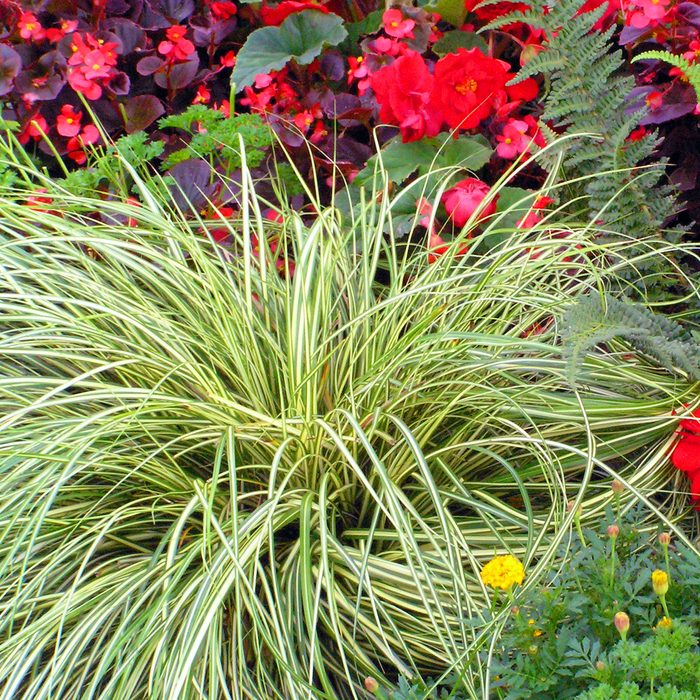
Sedges
Carex spp.
Wet areas of the garden can look fabulous when you plant this no-fuss, moisture-loving ornamental plant, which works well around ponds or other water features.
Learn how to plant a rain garden in your yard.
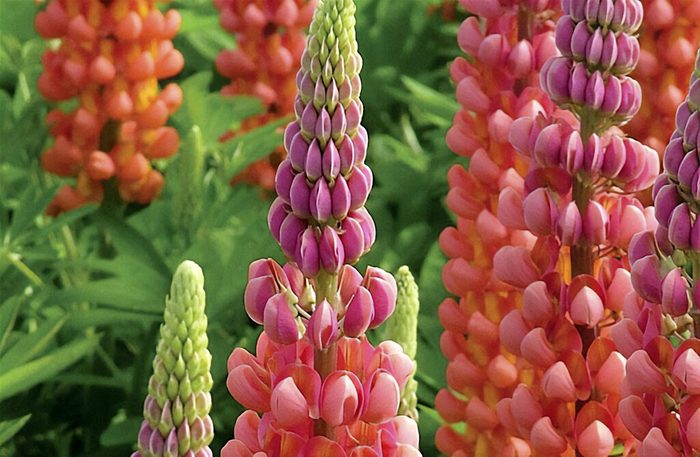
Lupines
Lupinus spp.
Graceful flower spikes in bold hues including multicolored blossoms draw bees and butterflies. These native wildflowers often reseed and thrive in sunny spots.
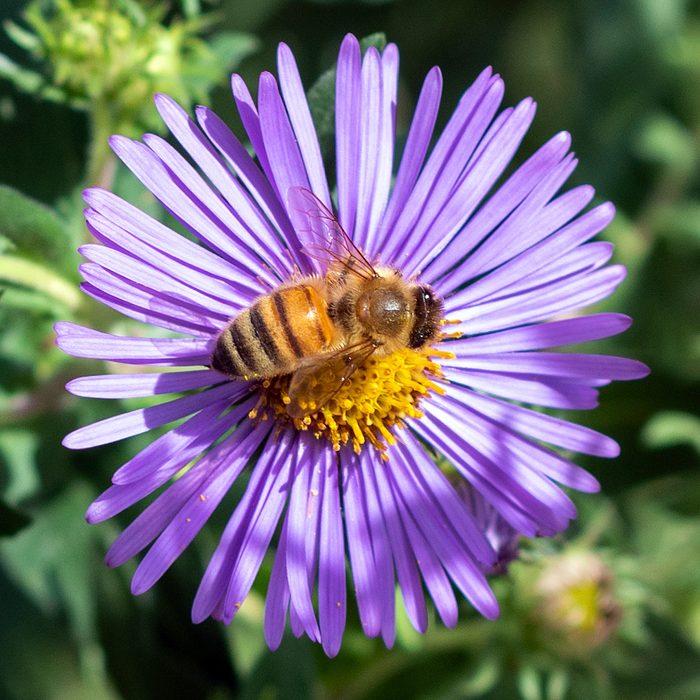
Asters
These late-season superstars offer a beautiful display of white, pink, blue or purple flowers that are easy to grow and are attractive to wildlife, but deer tend to ignore them.
The Value of Perennial Trial Gardens
Two resources that do the research for you to grow your best perennial garden.
- Mount Cuba Center, a nonprofit botanical garden in northern Delaware dedicated to native plants, recently trialed hundreds of varieties, including 75 different coneflowers. Check the Research page on their website to find the best options for your garden.
- All-America Selections, which trials vegetables, perennials and annuals across the U.S., offers a database of past winners on its website.
About the Expert
Kerry Ann Mendez is a nationally renowned expert gardener based in Maine. As the owner of Perennially Yours LLC, she’s published books about gardening and perennials, given gardening lectures, and maintains a gardening blog. She also offers home consultations to help homeowners get the most out of their garden.
Why Trust Us
For nearly 30 years, Birds & Blooms, a Trusted Media Brand, has been inspiring readers to have a lifelong love of birding, gardening and nature. We are the #1 bird and garden magazine in North America and a trusted online resource for over 15 million outdoor enthusiasts annually. Our library of thousands of informative articles and how-tos has been written by trusted journalists and fact-checked by bird and garden experts for accuracy. In addition to our staff of experienced gardeners and bird-watchers, we hire individuals who have years of education and hands-on experience with birding, bird feeding, gardening, butterflies, bugs and more. Learn more about Birds & Blooms, our field editor program, and our submission guidelines.
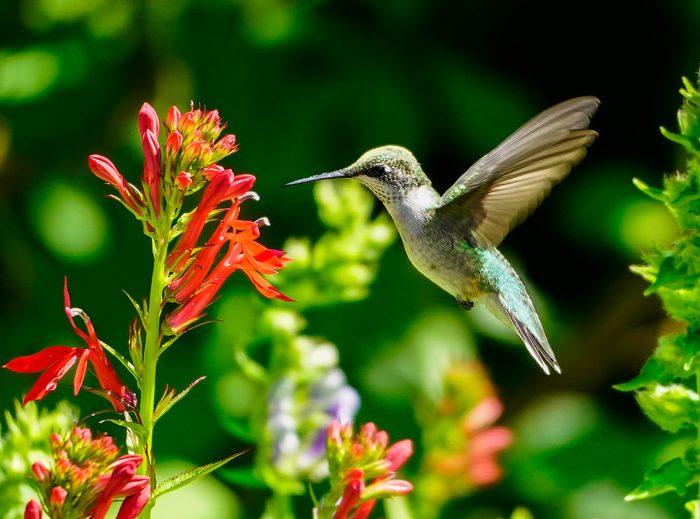
Hummingbirds are tiny but mighty—and the same can be said for some hummingbird gardens. In fact, small yards can be a gift. Unlike large spaces, it doesn’t take much effort, time or money to transform a bit of yard or patio into a hummingbird-friendly habitat.
And an added bonus: You’re more likely to have a front seat to the action when the fliers come to visit. Whether using containers or growing native plants or both, here’s how to welcome hummingbirds to a small garden.
On This Page
Use Potted Plants in a Hummingbird Garden
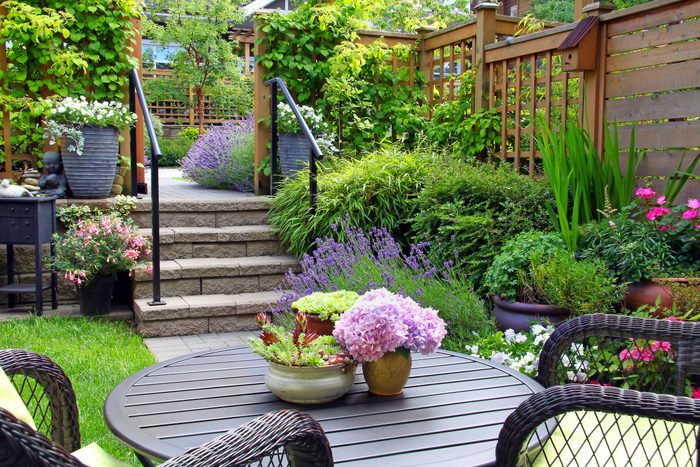
Pots and containers are excellent choices if you have concrete, paved or wooden spaces that you want to jazz up with some greenery. Flower boxes add a charming aspect to balconies, while deck boxes and tiered plant stands liven up decks and patios. Here’s a roundup of potted flowers and plants that attract hummingbirds. Even a side of your house can become a hummingbird garden when made into a “living wall.” Consider hanging baskets, too—just opt for large ones, as they accommodate bigger prolific bloomers.
Plant More Native Plants for Hummingbirds
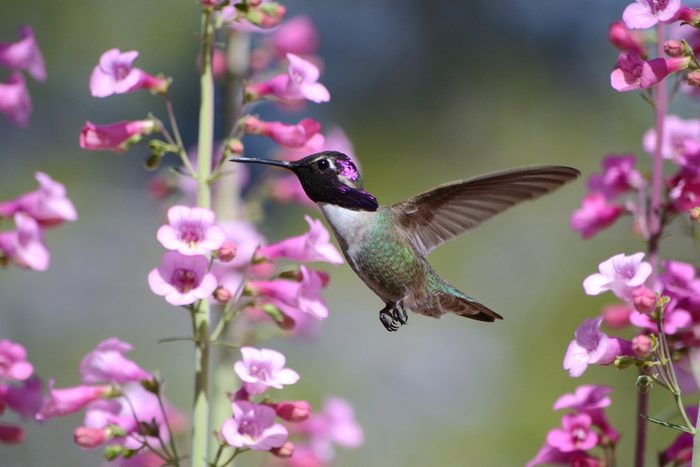
What you plant in containers can make all the difference. “A container garden is a wonderful way to provide more habitat for hummingbirds, particularly if you use native plants,” says John Rowden, the former senior director for bird-friendly communities at the National Audubon Society.
Consider adding penstemon, for starters. And don’t overlook several varieties of native columbine found across the U.S., along with cardinal flower. “The amazing thing about these plants is they’ve developed tubular blooms over time,” says John. “Hummingbirds adapted to sticking their bills into those blooms for nectar, which aids in pollination. It’s a mutually beneficial relationship.”
John notes that native plants act as fantastic hosts for native insects, too. While hummingbirds are known for their nectar needs, they also eat and feed insects to their young. “When planting native plants, you are supporting the life cycle of other species,” John says. “This helps provide an additional boost of resources for hummingbirds.”
Another popular way to attract hummingbirds to a garden of any size is with a sugar-water feeder. “Hummingbirds’ needs regarding nectar are so specific and quite regular, so they’ll always take advantage of those kinds of resources,” explains John, who notes that feeders should ideally be used in addition to native plants in a hummingbird garden to help fulfill a bird’s nutritional needs.
Grow a Vertical Hummingbird Garden
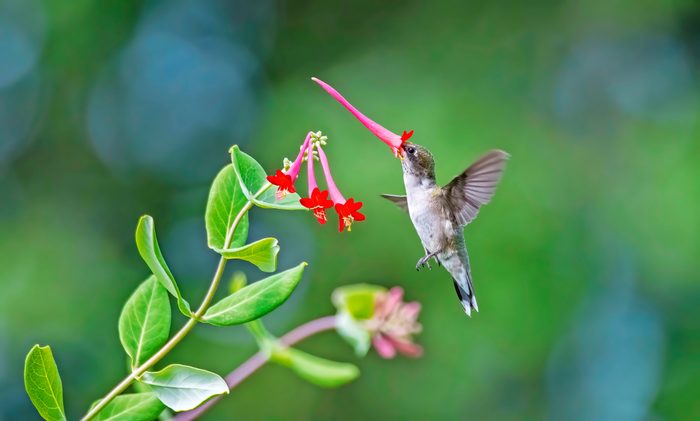
Look around a tiny yard and you may not see much real estate at first. But the options are nearly unlimited if you just think higher. Consider vining plants. Plant a purple passionflower near a pergola placed over a cafe table and chairs, which could prove to be the best seats in the house to view hummingbird activity.
Or create a privacy wall by securing lattice panels to deck railing. Then coax trumpet honeysuckle, which is another hummingbird favorite, to climb it. A pyramid trellis trained with clematis is sure to bring in birds, too, while also brightening a dull corner of the yard or patio.
Check out the top 10 vines for hummingbirds.
John reminds small-space dwellers to think deliberately about the plants they provide to hummers. “Be sure to think about the timing of flowers,” he suggests. “Consider when certain plants flower and space out the blooming cycle so the birds get those resources throughout the time period they are there.”
Add Water and Shelter for Hummingbirds
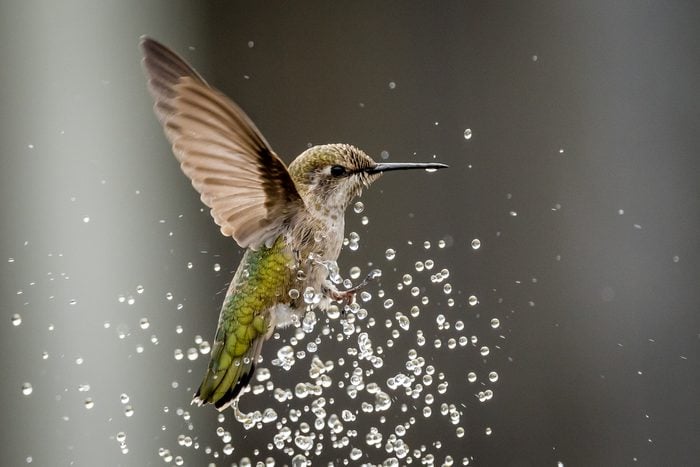
Like most other birds, hummers are skittish. While they don’t perch for long, they like places to hide as they zoom back and forth between hummingbird garden plants and feeders. Because of that, consider a small potted conifer shrub where they can have a quick rest. Many dwarf shrubs can be planted in containers.
Hummingbirds also love a water source such as a birdbath for a quick drink or to cool off in the heat of summer. Consider a mister or water feature with a fine spray (keep it off the ground or near a shrub to provide safety from predators). They love both the noise and water movement.
Our Top 15 Hummingbird Garden Plant Picks
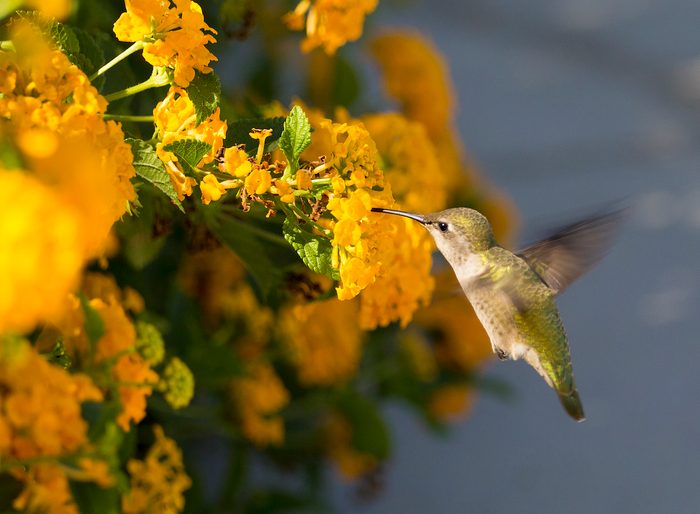
Choose the best flowers and grow a small-space hummingbird garden guaranteed to attract more of these tiny pollinators.
Native Plants for Hummingbird Gardens
- Cardinal flower
- Columbine
- Lupine
- Penstemon
- Trumpet honeysuckle
Vining Plants for Hummingbird Gardens
- Mandevilla
- Passionflower
- Pinkshell azalea
- Scarlet runner bean
- Trumpet vine
Container Plants for Hummingbird Gardens
Follow these expert tips to attract hummingbirds.
About the Expert
John Rowden has worked at the National Audubon Society since 2009. As senior director for Bird-friendly Communities from 2019 to 2022, he focused on making communities better and safer for birds, with involvement in programs such as Plants for Birds and Bird-friendly Buildings. He earned a PhD in Zoology from Duke University.
Why Trust Us
For nearly 30 years, Birds & Blooms, a Trusted Media Brand, has been inspiring readers to have a lifelong love of birding, gardening and nature. We are the #1 bird and garden magazine in North America and a trusted online resource for over 15 million outdoor enthusiasts annually. Our library of thousands of informative articles and how-tos has been written by trusted journalists and fact-checked by bird and garden experts for accuracy. In addition to our staff of experienced gardeners and bird-watchers, we hire individuals who have years of education and hands-on experience with birding, bird feeding, gardening, butterflies, bugs and more. Learn more about Birds & Blooms, our field editor program, and our submission guidelines.
On This Page
How to Identify a Great Gray Owl
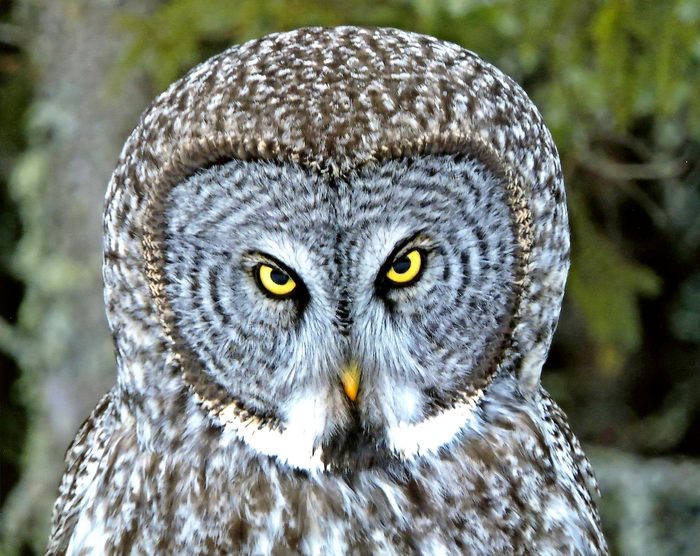
One of the most elusive and mysterious looking owls is the great gray. Despite being the largest type of owl in North America, the great gray is one of the most difficult to find.
Psst—follow these clues to spot the owl in your backyard trees.
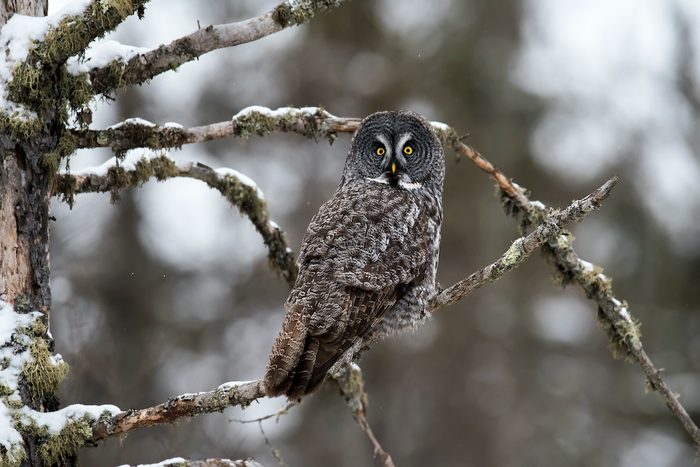
Great gray owls are easy to identify based on their large size, yellow eyes and a distinctive white bow tie mark under the chin.
Meet the smallest owl in the world—the elf owl.
Range and Habitat
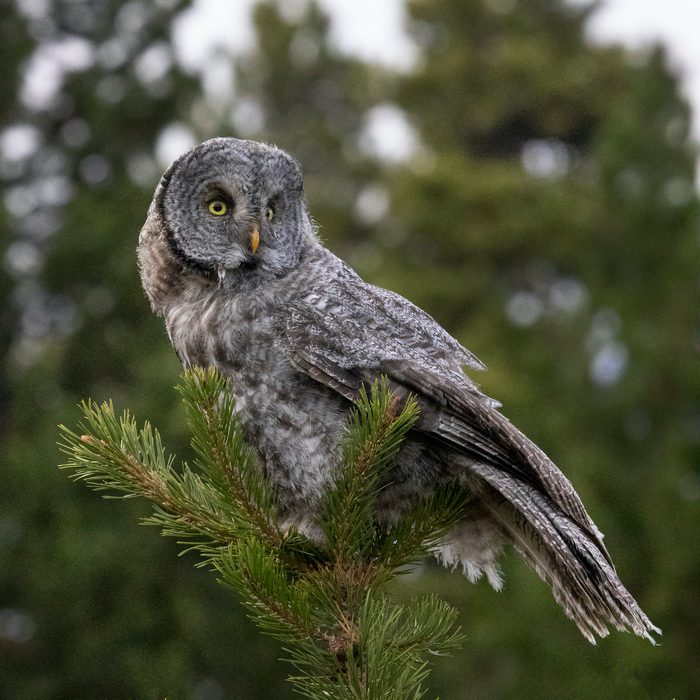
The species ranges across the forests of the West, in the mountains from California to Wyoming, as well as the boreal forest of Alaska and the western two-thirds of Canada. The more-than-2-foot-tall bird is perfectly camouflaged to reside in dense conifer forests.
Great gray owls rarely venture south, except when extreme cold forces them to seek food. Irruptions of this species only happen under the harshest of conditions.
Do owl sightings have special meaning?
Nesting Habits
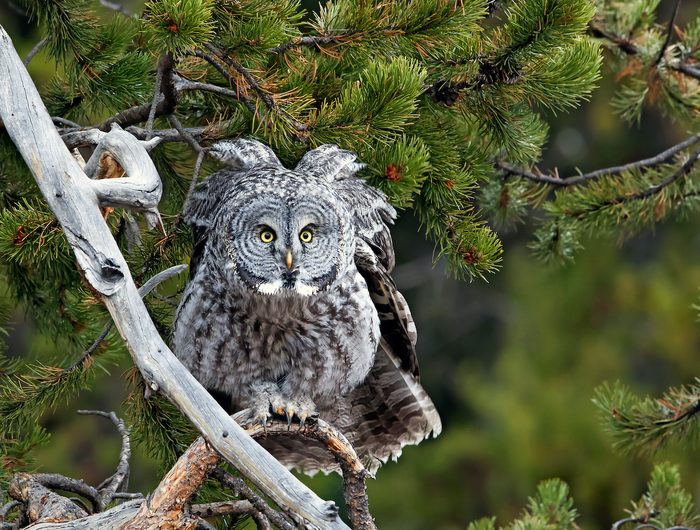
Rather than build their own nests, the giants take over structures built by squirrels, ravens or other raptors. Great grays will often return to the same nest year after year.
Great gray owls avoid populated areas, so they’re difficult to spot. But when caring for young, they’re more likely to venture out in daylight to hunt rodents.
Learn how to attract owls to nest in your yard.
Diet
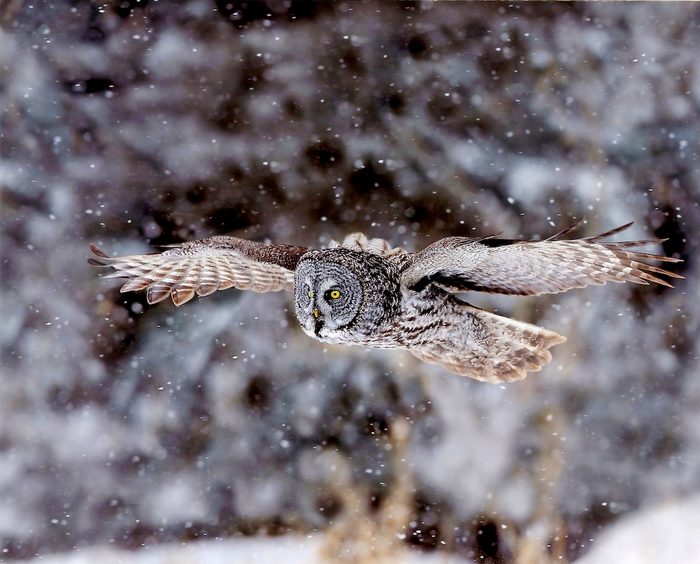
Great gray owls move out to open bogs, muskegs and meadows to hunt their small mammal prey. This owl is one of the mightiest and can plunge into deep snow to snag a vole snack. During winter, great gray owls consume up to seven rodents a day.
If you are lucky enough to see a great gray, resist the temptation to play calls or to feed it—both practices are unsafe for the owl. Instead, give the bird plenty of space. The memory will remain with you for forever.
Sounds
The Minnesota DNR reports that the great gray owl vocalizes with deep sounding, repetitive hoots.
Bird sounds courtesy of the Cornell Lab of Ornithology
Great Gray Owl Hotspot
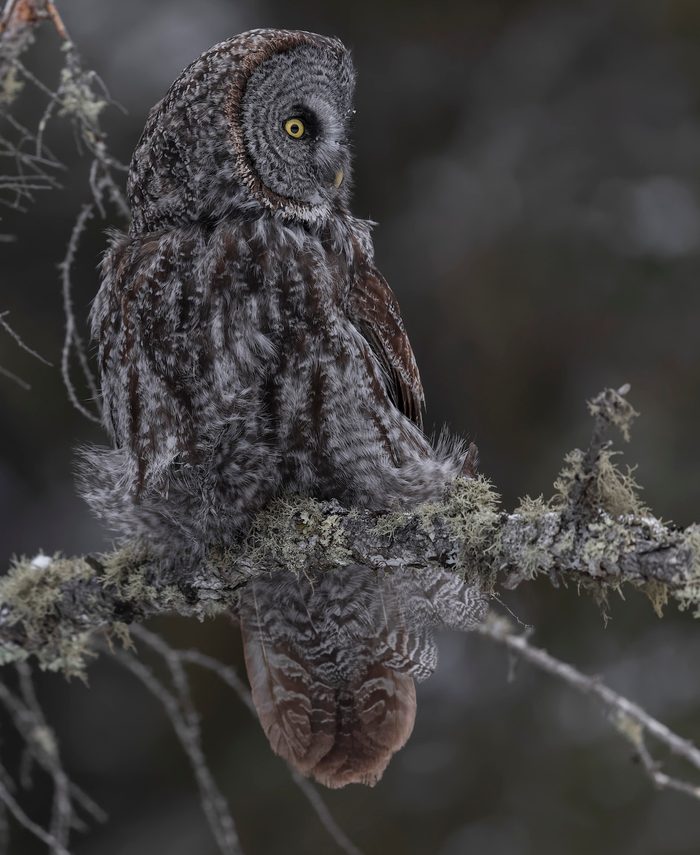
From December to March, Sax-Zim Bog in northern Minnesota becomes home to uncommon boreal birds from Canada.
“On a cold winter’s day in Sax-Zim Bog, we spotted this great gray owl (above) hunting along a gravel road. It is amazing how good their hearing is. He kept turning his head from side to side listening for the sounds of a vole moving beneath the snow. After about 10 minutes or so, he dove towards the ground and pounced on his meal. The snow was about a foot deep, but that didn’t keep him from a successful hunt. I was using a Canon R5 and a 600 f4 to photograph him,” says reader Kevin Oneill.
Next, learn fascinating snowy owl facts (and where to find them!)
Sources
- Minnesota DNR
- Cornell Lab of Ornithology
Why Trust Us
For nearly 30 years, Birds & Blooms, a Trusted Media Brand, has been inspiring readers to have a lifelong love of birding, gardening and nature. We are the #1 bird and garden magazine in North America and a trusted online resource for over 15 million outdoor enthusiasts annually. Our library of thousands of informative articles and how-tos has been written by trusted journalists and fact-checked by bird and garden experts for accuracy. In addition to our staff of experienced gardeners and bird-watchers, we hire individuals who have years of education and hands-on experience with birding, bird feeding, gardening, butterflies, bugs and more. Learn more about Birds & Blooms, our field editor program, and our submission guidelines.
On This Page
Penstemon Care and Growing Tips
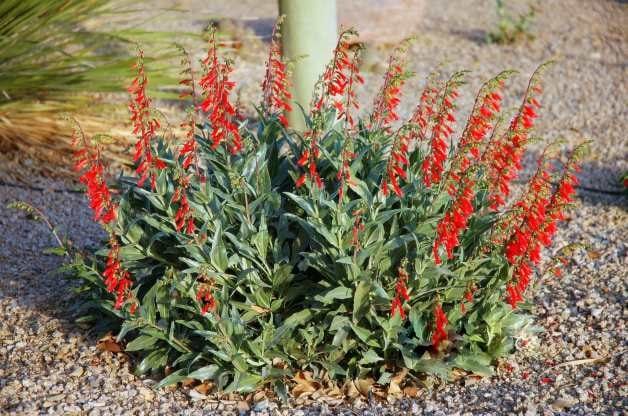
- Common name: Beardtongue
- Scientific name: Penstemon spp.
- Zones: 3 to 8 or 9, depending on variety
- Light needs: Full sun or filtered shade
- Soil: Well-draining
Native to North America, penstemon, commonly known as beardtongue, can thrive in many locations. With over 200 varieties available, there are many options for almost any garden.
Penstemon are versatile perennial plants, looking equally at home when planted in groups of three or five as in an informal garden design. They’re a great choice to use as edging plants in your borders.
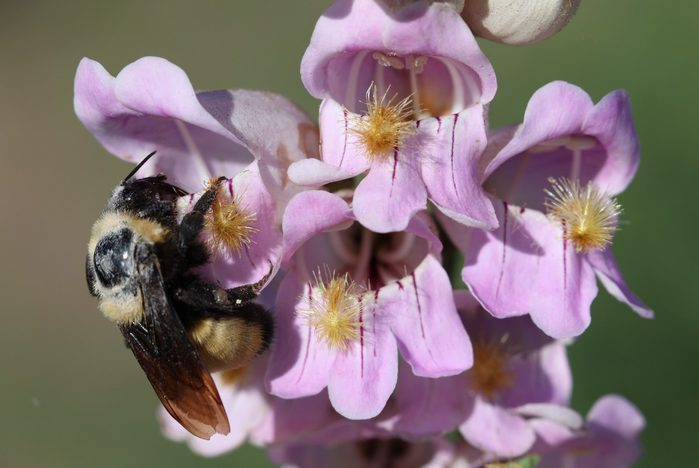
These low-maintenance perennials put on a great show. The majority are tough and drought-tolerant once established, and they shrug at neglect. Give them plenty of sun to ensure strong growth. These flowering plants do best in gardens with well-draining soil and some supplemental water during the warmest months of the year. Fertilizer isn’t needed. Rich, fertile soil will actually decrease flowering, and the plants won’t tolerate clay soil or wet feet in winter.
They begin flowering in late winter in areas with mild temperatures, and the blooms last through spring. In cooler regions, these water-wise plants flower later in the season and continue to bloom through summer. Their height increases dramatically when in flower, from 1 to 2 feet, up to 4 feet, depending on the species. Once the blooms fade, remove the flowering spikes.
Penstemon Varieties

Penstemon is a valuable addition to the drought-tolerant garden. Its tall flowering spikes paint the landscape in spring and summer. Each spike consists of multiple blossoms ranging in color, from white, pink, magenta, orange, purple and to red, depending on the variety.
Some types, such as Parry’s, do well in wildflower gardens because they are easy to start from seed. When planted among lupine, the blend of purple and pink adds a cooling touch.
I grow firecracker (Penstemon eatonii) and Parry’s (Penstemon parryi) in my desert Southwest garden. These plants are a magnet for Anna’s and Costa’s hummingbirds.
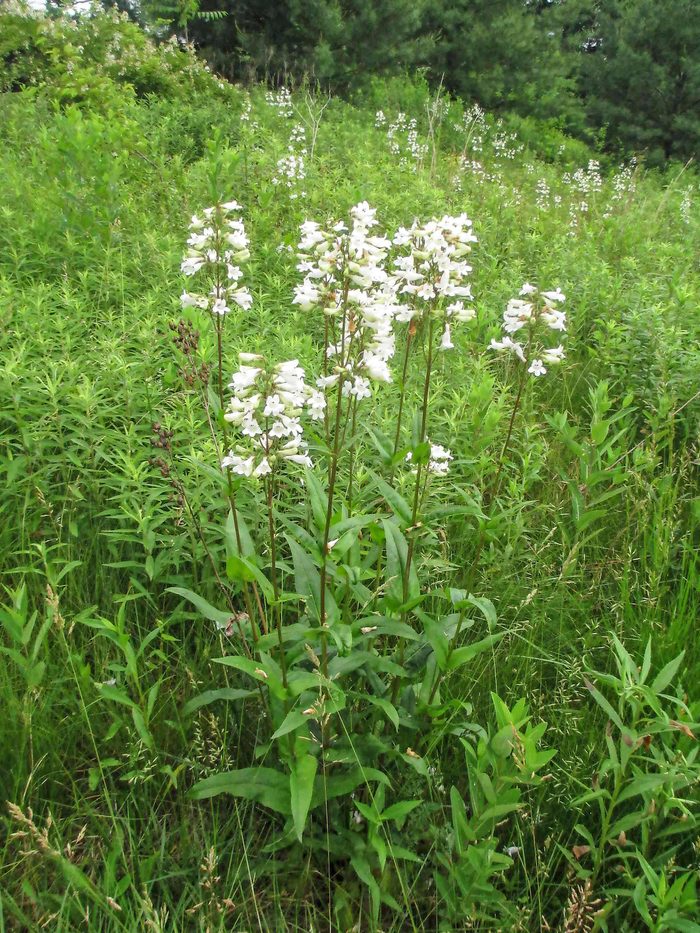
“I saw this plant last spring during my walks near a pond. It was in a field with other wildflowers. I can’t identify it. Any ideas?” asks Birds & Blooms reader Mary Ahearn of Pottstown, Pennsylvania.
Horticultural expert Melinda Myers says, “This tall stately plant is a Penstemon digitalis, also known as foxglove beardtongue. This North American native perennial is hardy in zones 3 to 8. It prefers full sun and will tolerate dry soil once established. The white flowers appear in spring through early summer and will attract butterflies to the garden. The birds enjoy the seeds and the deer tend to leave this plant alone. You may find several popular cultivars of this plant at your local garden center.”
Grow Penstemon for Hummingbirds and Bees
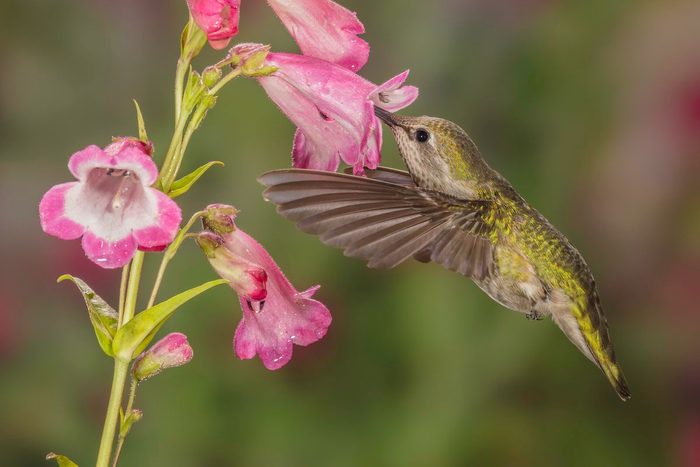
Besides adding beauty to your backyard, hummingbirds are drawn to penstemon’s nectar-filled tubular flowers, which makes it a must-have plant for every hummingbird garden.
Wherever you plant penstemon, be sure it’s near a window or your favorite sitting area. That way, you can see your visiting hummingbirds up close.
Discover the top 15 colorful hummingbird flowers to grow.
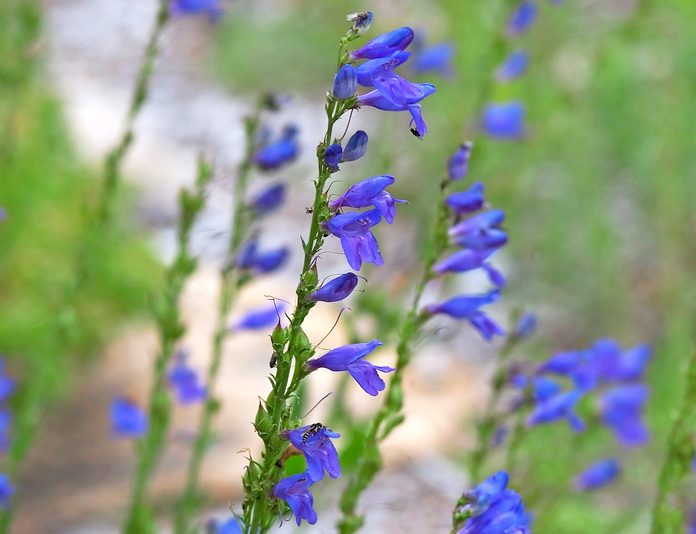
Hummingbirds aren’t the only pollinators that this plant attracts. Some types, like Rocky Mountain (Penstemon strictus), attract bumblebees as well. The bumblebees crawl right into the blossoms to drink nectar or fall asleep, leaving their back ends poking out. This easy-to-grow Mountain West native plant thrives in sun to part shade and dry soil.
Pineleaf (Penstemon pinifolius) features evergreen foliage that resembles pine needles and tubular flowers. It is deer-resistant, so there’s no need to worry about the plant getting eaten. Plant it on slopes or in rock gardens.
Both of these varieties are native to the Rocky Mountains; it’s best to choose penstemon varieties that are native to your area and suited to your growing conditions. Consult with your local extension office, garden center or a native plant expert.
About the Expert
Melinda Myers is the official gardening expert for Birds & Blooms. A TV/radio host, author and columnist, Melinda Myers has written more than 20 gardening books.
Sources
Why Trust Us
For nearly 30 years, Birds & Blooms, a Trusted Media Brand, has been inspiring readers to have a lifelong love of birding, gardening and nature. We are the #1 bird and garden magazine in North America and a trusted online resource for over 15 million outdoor enthusiasts annually. Our library of thousands of informative articles and how-tos has been written by trusted journalists and fact-checked by bird and garden experts for accuracy. In addition to our staff of experienced gardeners and bird-watchers, we hire individuals who have years of education and hands-on experience with birding, bird feeding, gardening, butterflies, bugs and more. Learn more about Birds & Blooms, our field editor program, and our submission guidelines.
Sure, we love plants for their beauty and fragrance, but have you ever browsed the aisles of your local garden center and felt your creative side, I don’t know, sigh just a little? That’s a huge problem: settling for the tried-and-true when you’re really craving weird, funny-looking plants that belong in a school science fair.
But committing to adventure often leads to disappointment. Either you can’t find a place to buy the weird plants you’re looking for, or the plant is too temperamental for the average gardener.
But all hope is not lost! With a little work, anyone can grow these out-of-the-ordinary plants at home.
On This Page
Giant Allium
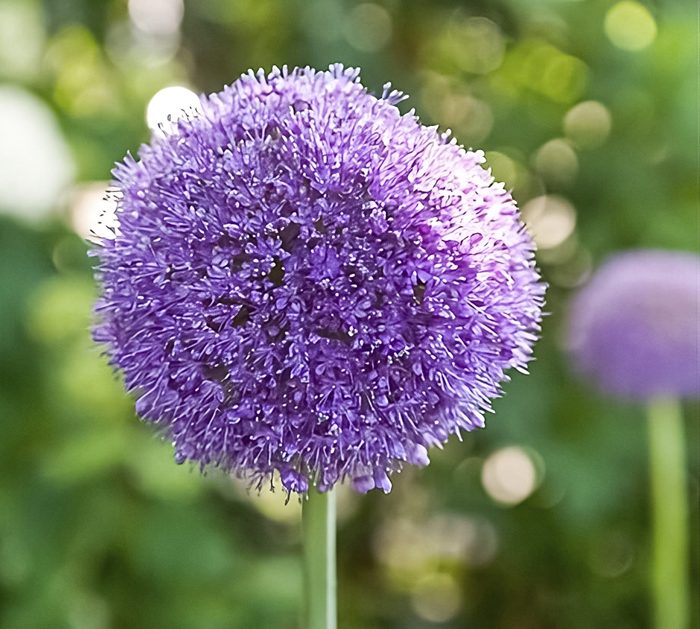
Allium giganteum, Zones 4 to 8
It’s not just the umbel of star-shaped flowers that make the giant allium a showstopper, it’s the sheer size of this bulbous perennial. The deep purple blooms are 5 to 6 inches in diameter, and the stems reach a height of up to 50 inches, giving the summer bloomer a serious wow factor.
Why we love it: The height makes it an ideal filler (or thriller!) at the back of the garden bed.
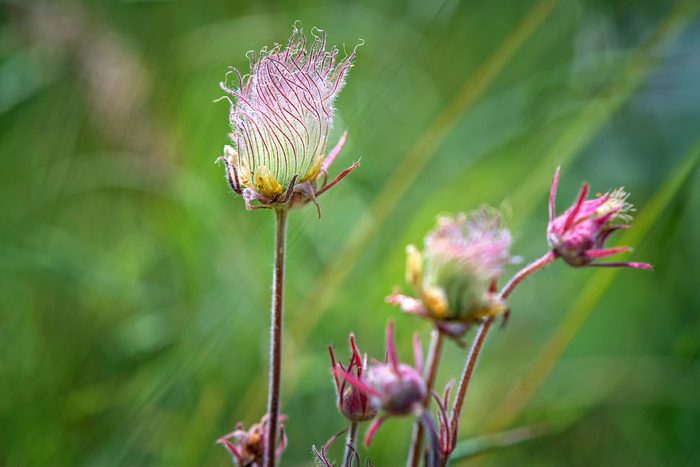
Prairie Smoke
Geum triflorum, Zones 3 to 7
This late-spring bloomer thrives in woodland and wildflower gardens. Clusters of reddish pink, maroon or purple flowers with fused sepals bloom in groups of three. The flowers are followed by fluffy seed heads in shades of silvery pink. In the fall, the semievergreen leaves turn red, orange or purple.
Why we love it: A native North American perennial, prairie smoke is said to have medicinal properties.
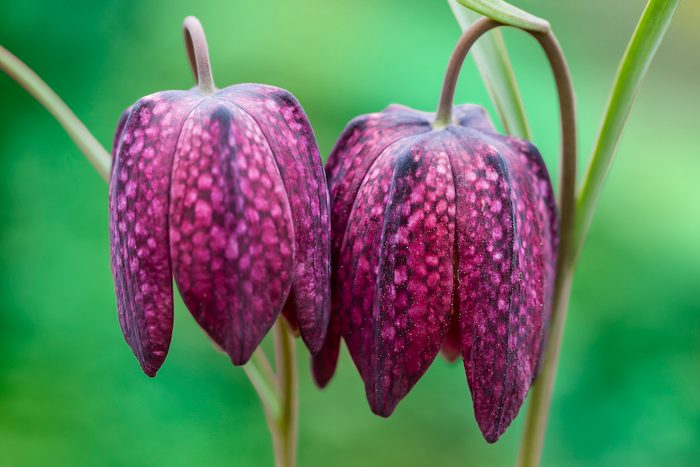
Snake’s Head Fritillary
Fritillaria meleagris, Zones 3 to 8
In April, the low-maintenance bulb produces delicate blossoms on slender stems. The bell-shaped blooms boast a checkered pattern in reddish brown, purple, white and gray shades. The pattern pops when the bulbs are planted in clusters.
Why we love it: This low-growing perennial is deer resistant, making it an excellent spring bloom.
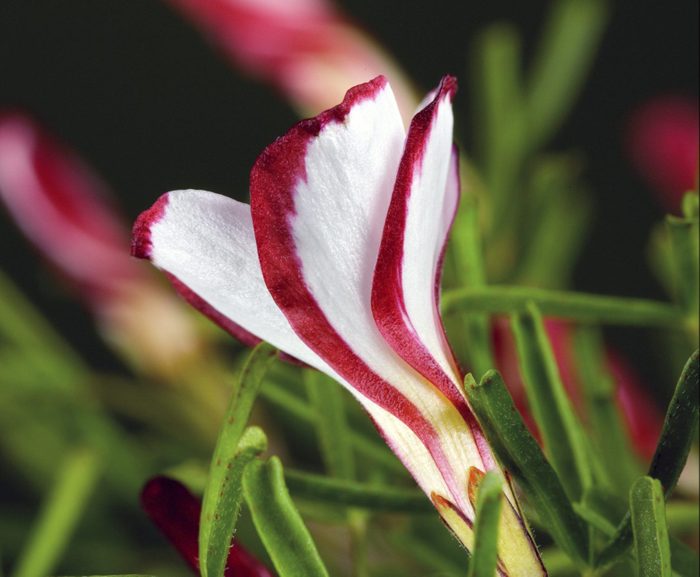
Candy Cane Sorrel
Oxalis versicolor, Zones 7 to 9
The swirls of red and white on the bud of this festive flower mimic the colors of a candy cane. The buds unfurl during sunny weather to reveal white petals rimmed in red. The plant grows well in full sun, and the blooms last from midsummer through fall.
Why we love it: Watch this plant thrive in a container and even as a houseplant.
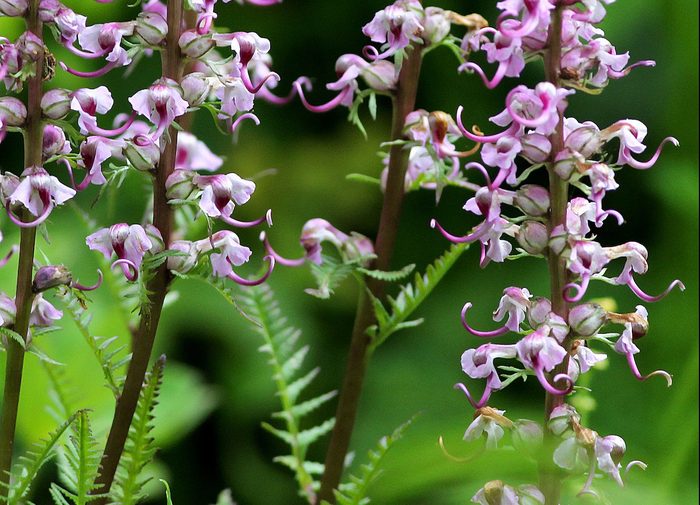
Elephanthead Lousewort
Pedicularis groenlandica, Zones 2 to 7
Purplish leaves appear after the snow melts, and soon after, it produces pinkish purple petals that resemble an elephant’s head. The perennial grows up to 2 feet tall, and although it can be a challenge to grow, the flowers are a great source of pollen for bees.
Why we love it: With a native habitat at high elevations, it’s ideal for northern gardens.
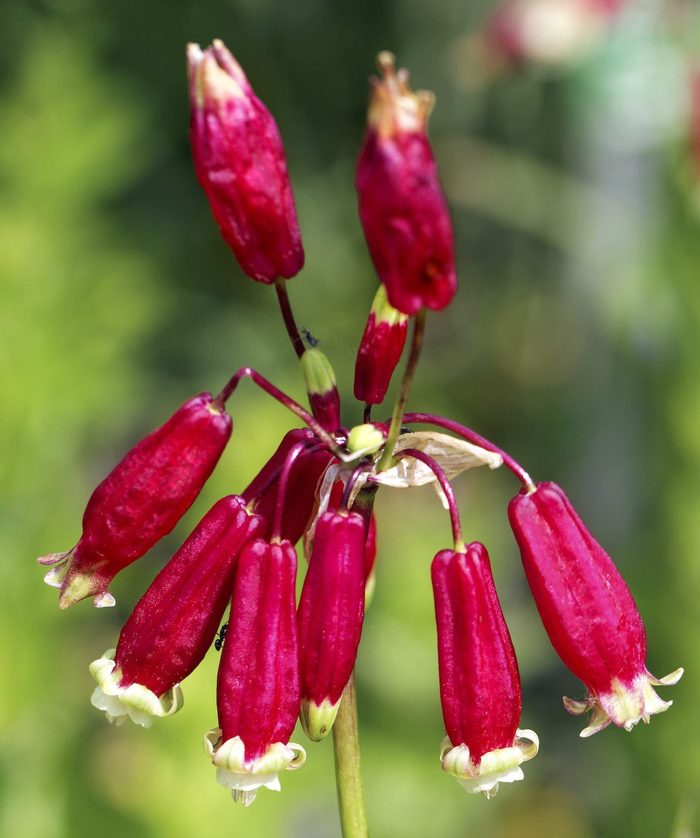
Firecracker Flower
Dichelostemma ida-maia, Zones 7 to 10
Red, pink or green flowers grow in clusters resembling their namesake with fuses attached to the stems. The herbaceous perennial is native to Oregon and California, where it’s abundant in woods and coastal grasslands. It grows up to 3 feet tall and blooms from May through July.
Why we love it: A favorite of hummingbirds and bees, it tolerates poor soil, shade and drought.
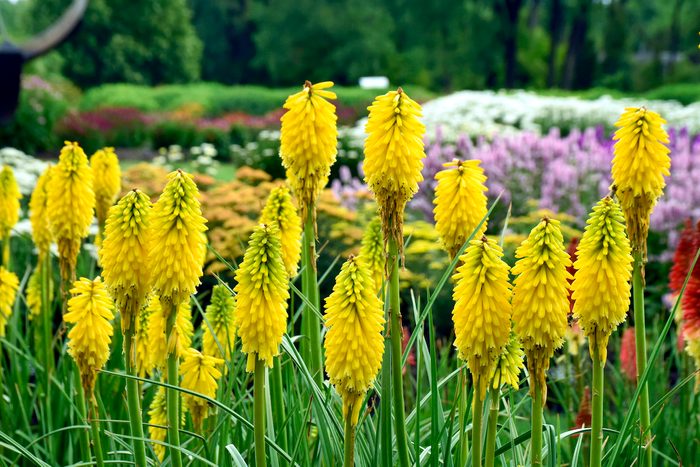
Red Hot Poker
Kniphofia, Zones 5 to 9
Flowering spikes bursting with tubular florets add plenty of drama to any collection of weird plants. The flowers appear in late spring through summer on tall spikes over grassy foliage. Native to southern and eastern Africa, red hot poker thrives in full sun and hot climates.
Why we love it: Different varieties have varying shades of flowers, from cream and yellow to orange and red.
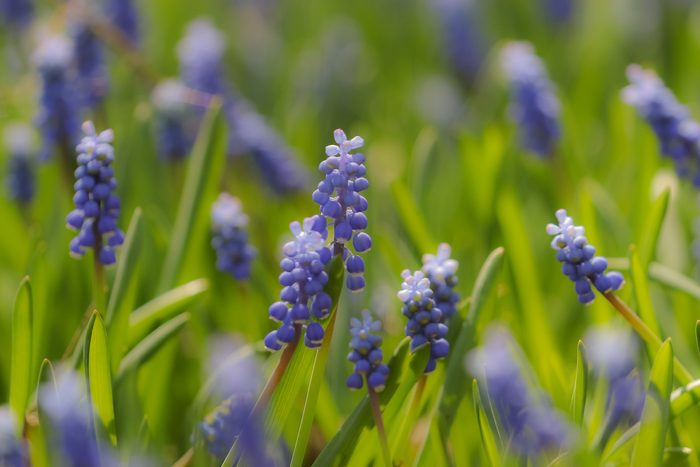
Grape Hyacinth
Muscari paradoxum, Zones 5 to 8
An heirloom classic, grape hyacinth is a perennial favorite. The first flowers appear in March and become spikes bursting with blooms that last through May.
Why we love it: Beautiful and fragrant, it is an early spring favorite of pollinators.
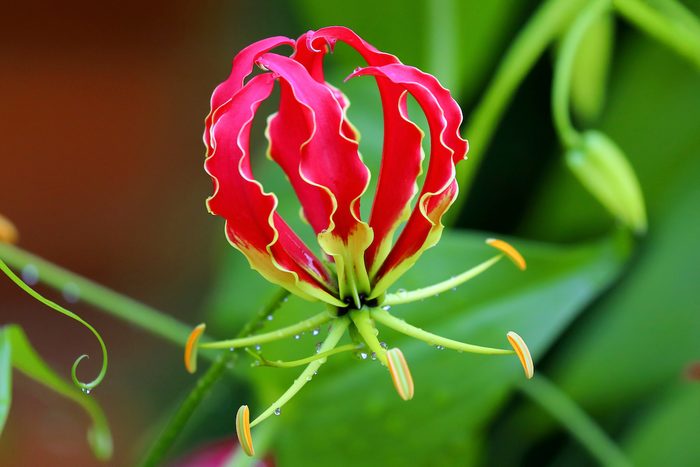
Gloriosa Lily
Gloriosa superba, Zones 8 to 10
The national flower of Zimbabwe, gloriosa lily grows best in temperate and tropical climates, but it can also be grown as a summer bulb in colder areas or in containers where weediness or invasive potential is a concern.
Why we love it: The slender stems and tendrils are great at climbing walls or trellises, reaching lengths of up to 15 feet.
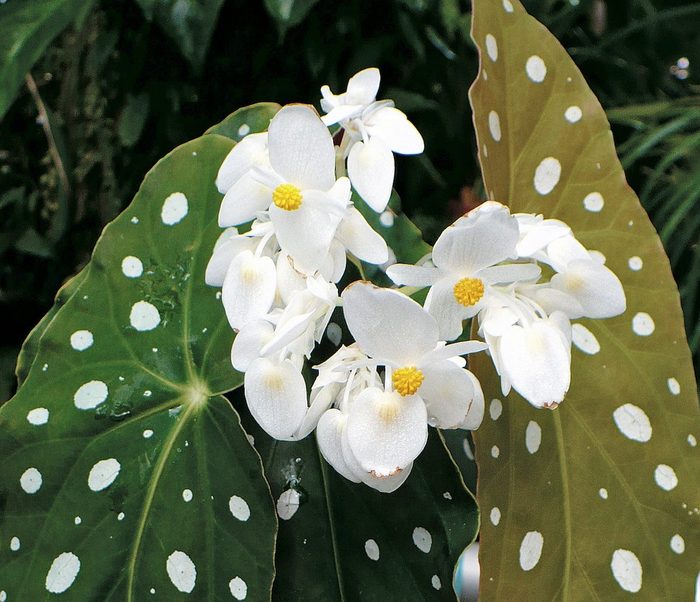
Polka Dot Begonia
Begonia maculata var. wightii, Annual
An impressive height of 3 to 4 feet provides a good view of this begonia’s striking leaves. The elongated-heart shape and ruffled edges make for lovely foliage, but the round, sparkly white spots steal the show.
Why we love it: It’s not just beautiful—it’s a brilliant example of nature’s engineering. It is believed that the spots scatter sunlight within the leaves, helping this begonia adapt to lower light below a forest canopy.
After you read our list of weird plants, check out more fabulous foliage plants for garden pizzazz.
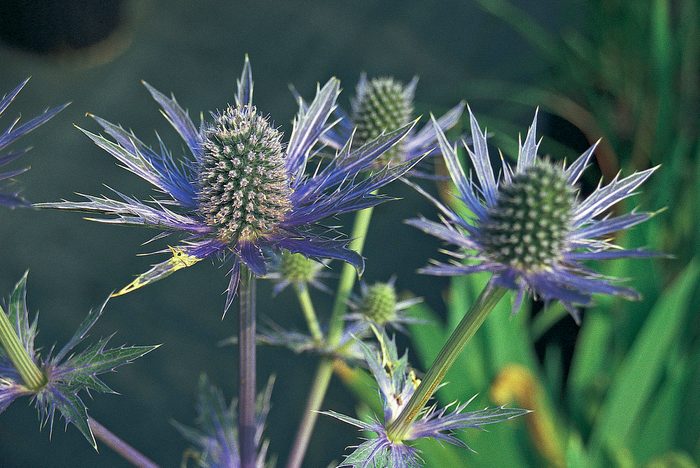
Sea Holly
Eryngium, Zones 5 to 8
Like the coneflower, sea holly is a relatively hardy perennial, sporting a central head ringed with a ruff of “petals.” Except these aren’t petals, but bracts that also sprout out along the stem. And the cone is covered with individual, fully functioning flowers, complete with male and female parts.
Why we love it: Sea holly is the Dr. Jekyll to coneflower’s Mr. Hyde, with its spiky bracts and eerie metallic hue.
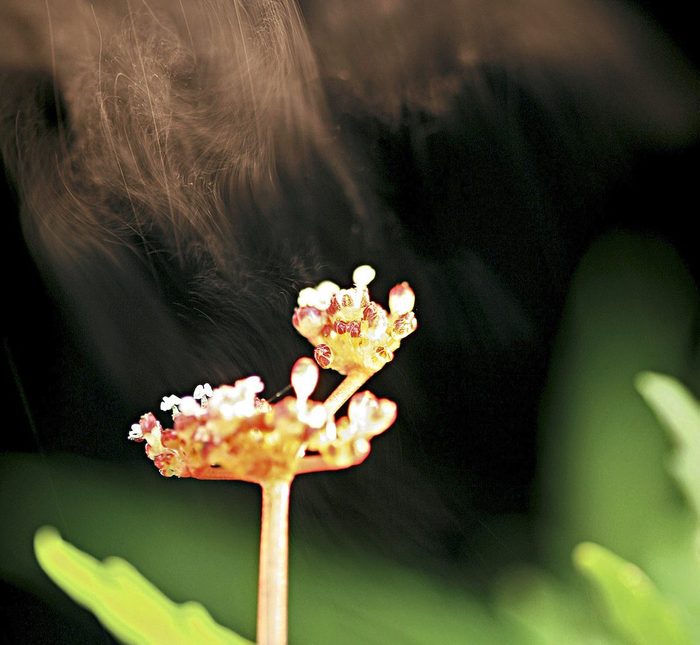
Artillery Plant
Pilea semidentata, Zones 11 to 12
It’s easy to grow this compact perennial indoors near a window or outdoors on a bright patio. With tiny green leaves on multiple stems, the artillery plant offers a pleasing mound of green year-round. Periodically, flat-topped inflorescences appear, tipped with tiny reddish buds. Watch carefully as they plump up.
Why we love it: Mist those fattened buds and wait about 30 seconds. Poof! Whoof! Puffs of pollen begin bursting out as the flowers open, wafting up like smoke from a cannon.
Check out 10 seriously cool succulents that make great houseplants.
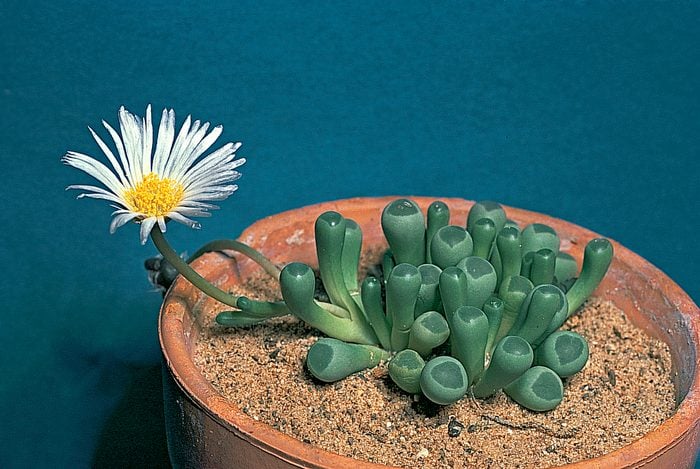
Baby Toes
Fenestraria rhopalophylla, Zones 10 to 12
Like other window-leaved succulents, this one has chubby leaves tipped with triangular patches of translucent pigment. The windows protect these weird plants from burning desert rays while letting in just enough light for photosynthesis. A large white flower rises up from the sand to attract pollinators.
Why we love it: In bright light, baby toes produce a red pigment that gives them further protection from the sun. They take on a pink tinge, almost seeming to blush.
No green thumb? Try the top 10 hard to kill houseplants.
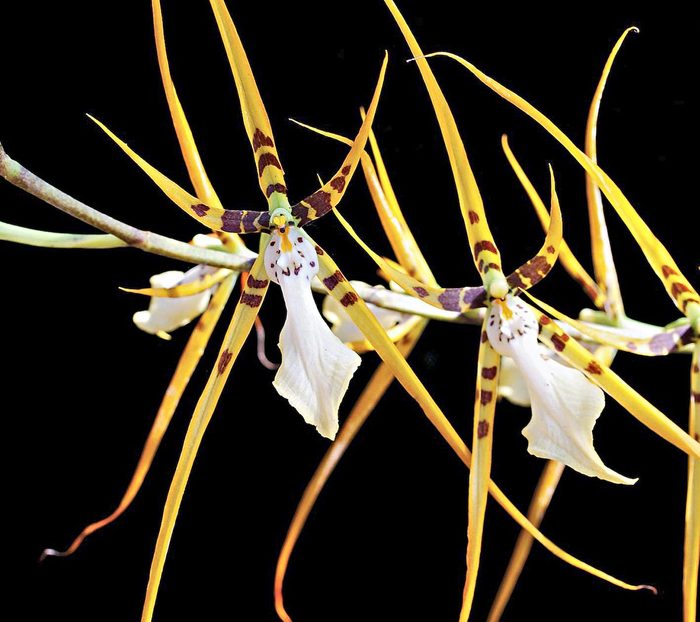
Spider Orchid
Brassia, Zone 12
To me, it looks like a skinny starfish on a stalk. But to wasps, the five banded petals of this tropical orchid resemble big, tasty spiders. While wrestling with the blooms, a wasp becomes covered in pollen, which it will helpfully—though hungrily—take to the next spider orchid.
Why we love it: When it comes to botanical moxie, it’s hard to beat a wasp-wrangling orchid.
Here’s our complete guide to growing orchids.
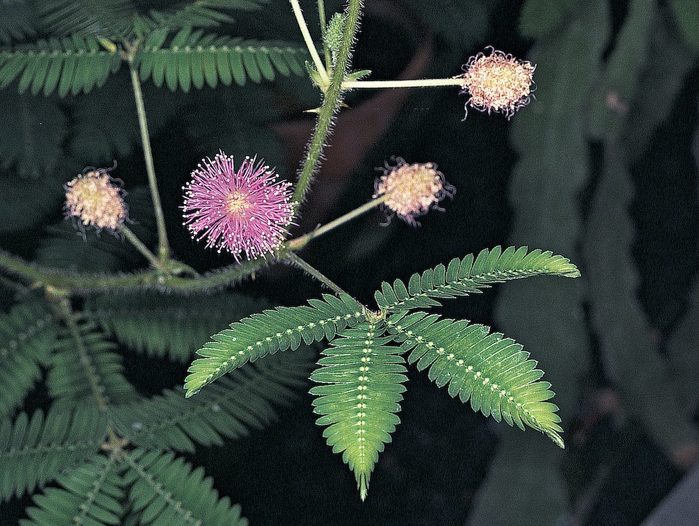
Sensitive Plant
Mimosa pudica
With delicate powder-puff flowers and lacy fernlike leaflets, the sensitive plant seems to earn the name pudica—shy—based on appearance alone. But touch it gently and the leaves fold up, one pair at a time, all the way down the axis.
Why we love it: Within 15 to 20 minutes, the leaflets open back up. It’s hard not to admire such resilience.
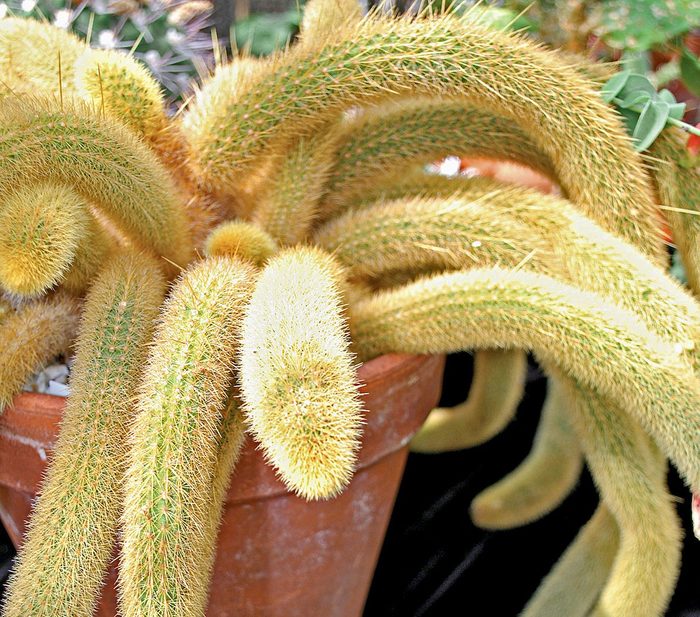
Tarantula Cactus
Cleistocactus winteri, Zones 9 to 11
In its native Bolivia, this cactus creeps along the rocky ground—but in a tall pot, its stems bend to resemble an enormous, hairy spider emerging from its hole. Just when you get super creeped out, pretty salmon-colored flowers bloom.
Why we love it: With regular water and fertilizer, it can grow several inches each year, making this one of our weird plants more fun than horrifying.
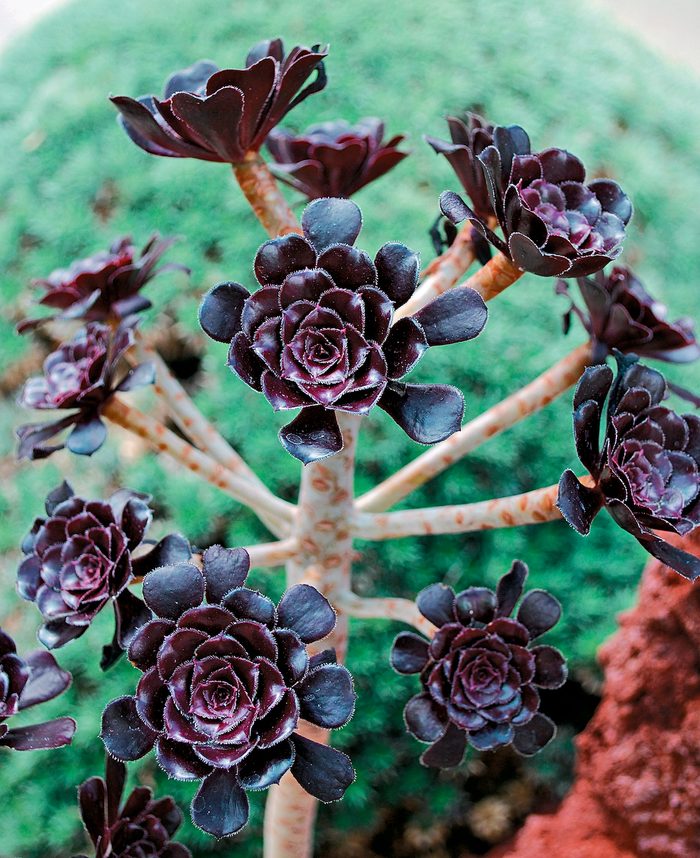
Black Tree Aeonium
Aeonium arboreum ‘Zwartkop’, Zones 9 to 11
Tight rosettes of leaves high atop narrow, gently crooking stalks: Even without the murky coloration, the black tree aeonium smacks of the Gothic. But this perennial craves bright light and warmth, so be prepared to bring it indoors for winter.
Why we love it: Black tree aeonium doesn’t bloom easily, but when it does, the breathtaking contrast of yellow flowers against the dark leaves makes all the effort worthwhile.
Like the dark side? Don’t miss the top 10 black annual and perennial plants.
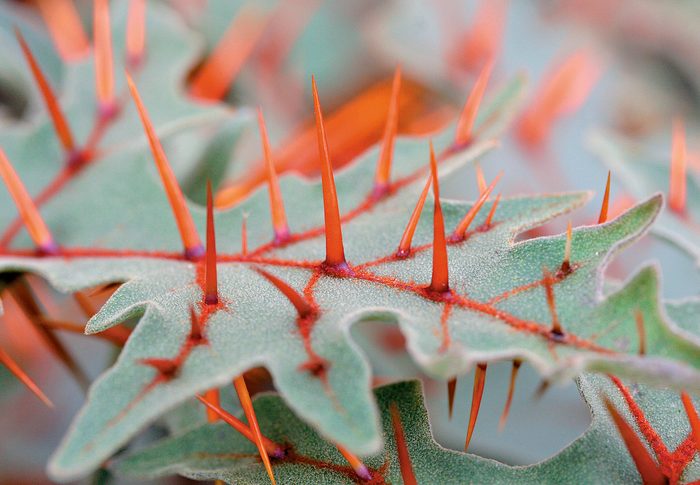
Porcupine Tomato
Solanum pyracanthum, Zones 9 to 11
It starts out innocently enough, a 2-foot-tall plant with elegant lobe-shaped, gray-green leaves. Then—bam!—bright spines start popping up through those leaves. The leaf tops, the undersides, the stems and even the fruit sport these pointy prickles. Note that all parts of these weird plants are poisonous.
Why we love it: Petals usually get all the points for prettiness, making porcupine tomato (also known as devil’s thorn) a lovable, although far from huggable, underdog.
Sources
- Timber Press Bizarre Botanicals by Larry Mellichamp and Paula Gross
- University of Wisconsin-Madison Division of Extension, Prairie Smoke
- North Carolina Cooperative Extension – Giant Allium
- Missouri Botanical Garden – Snake’s Head Fritillary
- North Carolina Cooperative Extension – Gloriosa Lily
- University of Wisconsin-Madison Division of Extension – Gloriosa Lily
- North Carolina Cooperative Extension – Firecracker Flower
- Lady Bird Johnson Wildflower Center – Firecracker Flower
- Missouri Botanical Garden – Red Hot Poker
- Lady Bird Johnson Wildflower Center – Elephanthead Lousewort
Why Trust Us
For nearly 30 years, Birds & Blooms, a Trusted Media Brand, has been inspiring readers to have a lifelong love of birding, gardening and nature. We are the #1 bird and garden magazine in North America and a trusted online resource for over 15 million outdoor enthusiasts annually. Our library of thousands of informative articles and how-tos has been written by trusted journalists and fact-checked by bird and garden experts for accuracy. In addition to our staff of experienced gardeners and bird-watchers, we hire individuals who have years of education and hands-on experience with birding, bird feeding, gardening, butterflies, bugs and more. Learn more about Birds & Blooms, our field editor program, and our submission guidelines.
While other woodpeckers hammer out their meals from trees or buildings, the Lewis’s woodpecker employs a more graceful yet nontraditional technique. “They catch insects on the wing,” says wildlife biologist Kaly Adkins, who works with the Oregon Department of Fish & Wildlife. “They are super fascinating because they feed like a flycatcher and fly like a crow.”
On This Page
What Does a Lewis’s Woodpecker Look Like?
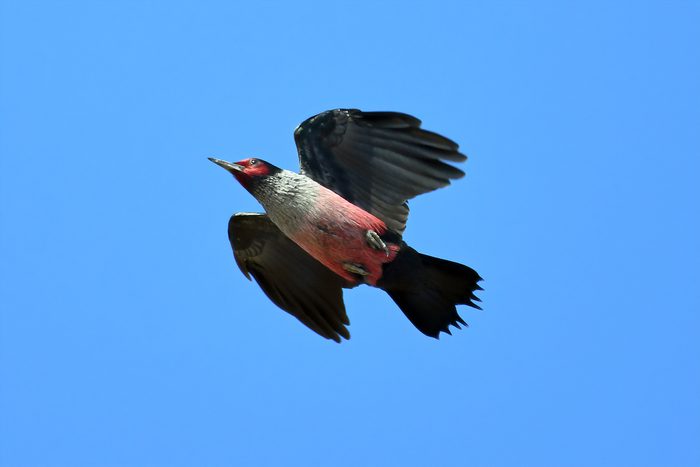
With its slow wing beats and long glides, this 10-to-11-inch-long bird might be mistaken for a crow or jay until its beautiful coloration is visible. “They have brilliant, iridescent colors,” Kaly says. “There is black and green plumage on their back to blend in with burnt trees. And they are cute with those pink bellies.”
Males and females look alike, although the males are slightly larger. Both share the black bill, gray collar and red on their faces, as well as relatively long wings and tails.
Lewis’s woodpeckers were described by, and later named for, Capt. Meriwether Lewis of the Lewis and Clark expedition who observed them in 1806 in western Montana. The species was initially known scientifically as Picus torquatus, meaning “woodpecker with a necklace.”
Nesting Habits
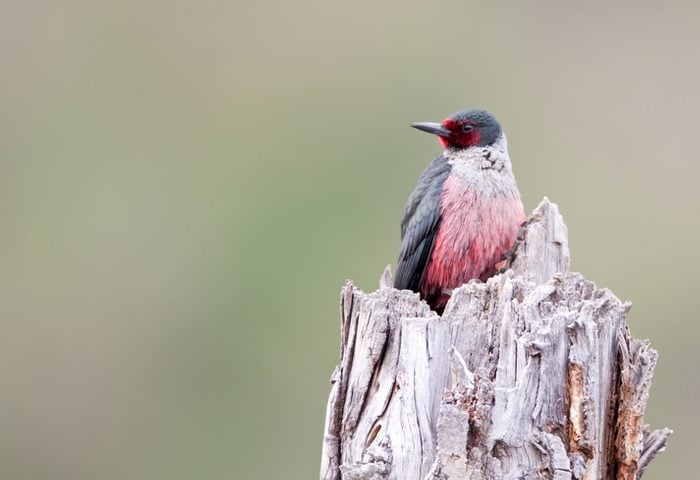
Lewis’s woodpeckers lack the heavy skull structure of other woodpeckers and are predominantly secondary cavity nesters in decaying trees, which is one reason it’s beneficial for homeowners in their range to allow standing dead or decaying trees to remain whenever possible.
“They recycle a lot of flicker nests,” Kaly says. Lewis’s woodpeckers nest between mid-April to early June. They sometimes expand the cavity and line it with bark chips, where they’ll raise one clutch with five to nine eggs. Both parents incubate the eggs and care for the young.
What Does a Lewis’s Woodpecker Eat?
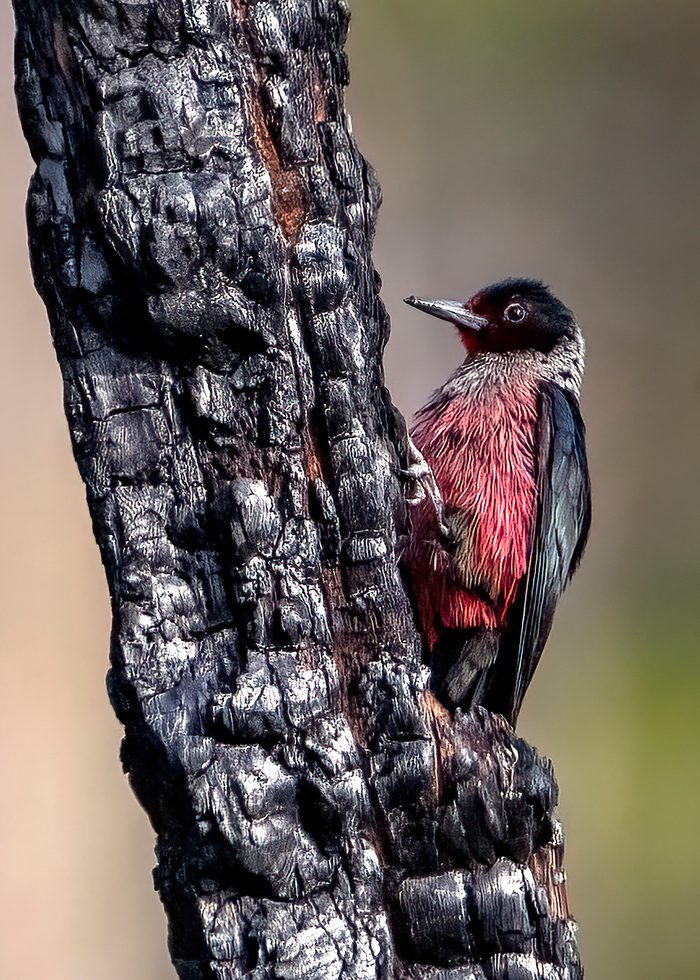
Lewis’s woodpeckers are omnivores, but their eating habits focus on what’s available. In their range, which covers areas in the western half of the U.S. and expands into British Columbia, they focus mainly on insects in the warmer months, sometimes adding fruit to the menu. They gather and store acorns and nuts in tree limb crevices for later use when insects are not prevalent.
Unlike other woodpeckers, Lewis’s often perch on a branch and swoop after flying insects.
“Flycatching from atop a 100-foot snag on the shoulders of Mount Jefferson in Oregon, the aerial maneuvers of Lewis’s woodpeckers are stunning. The iridescent green, black, red and silver colors make the Lewis’s an outstanding resident of central Oregon and the Cascades. This particular woodpecker (above) was enjoying bugs after a burn,” says Birds & Blooms reader Douglas Beall of Camp Sherman, Oregon.
Migration and Range
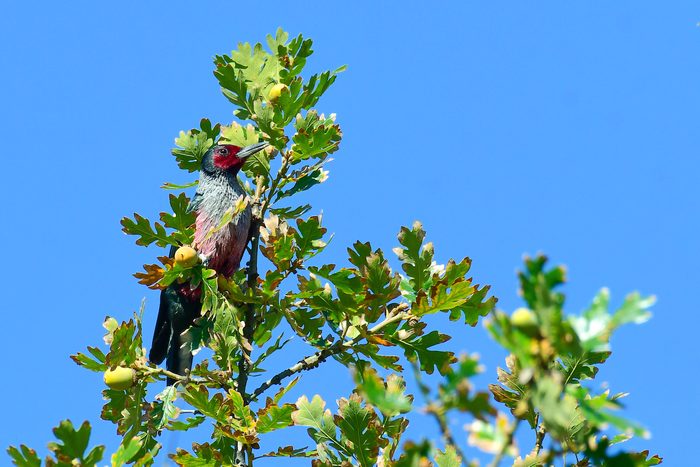
“For many species, migration is well defined, but we know Lewis’s woodpeckers are more versatile in their migration strategy,” Kaly says. In the fall some Lewis’s in the northern range migrate south, while others, particularly in temperate areas along the West Coast, remain in their home range the entire year.
There’s a strong connection between these woodpeckers and wildfires in their range: The open post-fire landscape often means more aerial hunting opportunities. Plus, standing dead trees provide important nesting opportunities for them.
Sound and Calls
Bird songs courtesy of the Cornell Lab of Ornithology
About the Expert
Kaly Adkins is a wildlife and conservation biologist who works with the Oregon Department of Fish & Wildlife. Kaly has also studied movement and activity of rare Sierra Nevada red foxes, bats and wolverines.
Sources
- Joint Fire Science Program – Fire Science Brief
- Cornell Lab of Ornithology
- Washington NatureMapping Foundation
- Lewis & Clark Trail Heritage Foundation
- eBird
- U.S Geologicial Survey – Mount Jefferson
Why Trust Us
For nearly 30 years, Birds & Blooms, a Trusted Media Brand, has been inspiring readers to have a lifelong love of birding, gardening and nature. We are the #1 bird and garden magazine in North America and a trusted online resource for over 15 million outdoor enthusiasts annually. Our library of thousands of informative articles and how-tos has been written by trusted journalists and fact-checked by bird and garden experts for accuracy. In addition to our staff of experienced gardeners and bird-watchers, we hire individuals who have years of education and hands-on experience with birding, bird feeding, gardening, butterflies, bugs and more. Learn more about Birds & Blooms, our field editor program, and our submission guidelines.
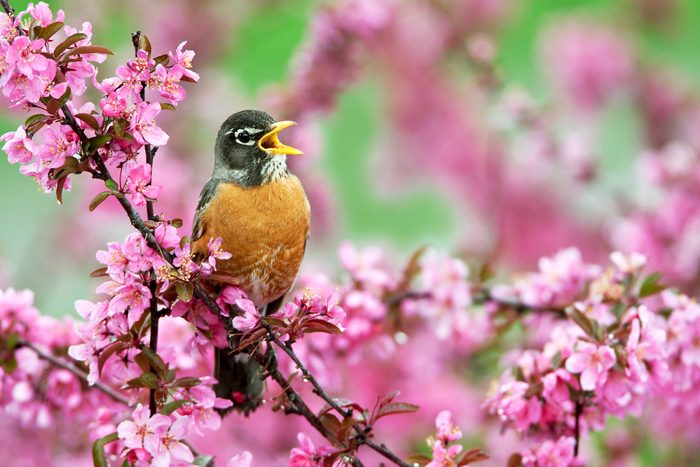
One of the joys of spring and early summer is the sheer abundance of bird songs filling the outdoors. Every kind of bird adds to the chorus with its own particular sounds—often beautiful, sometimes harsh, but always interesting. It’s possible to enjoy this free concert for its musical quality, but it becomes even more fascinating when we know why the birds make these sounds.
On This Page
Bird Songs or Calls: What’s the Difference?
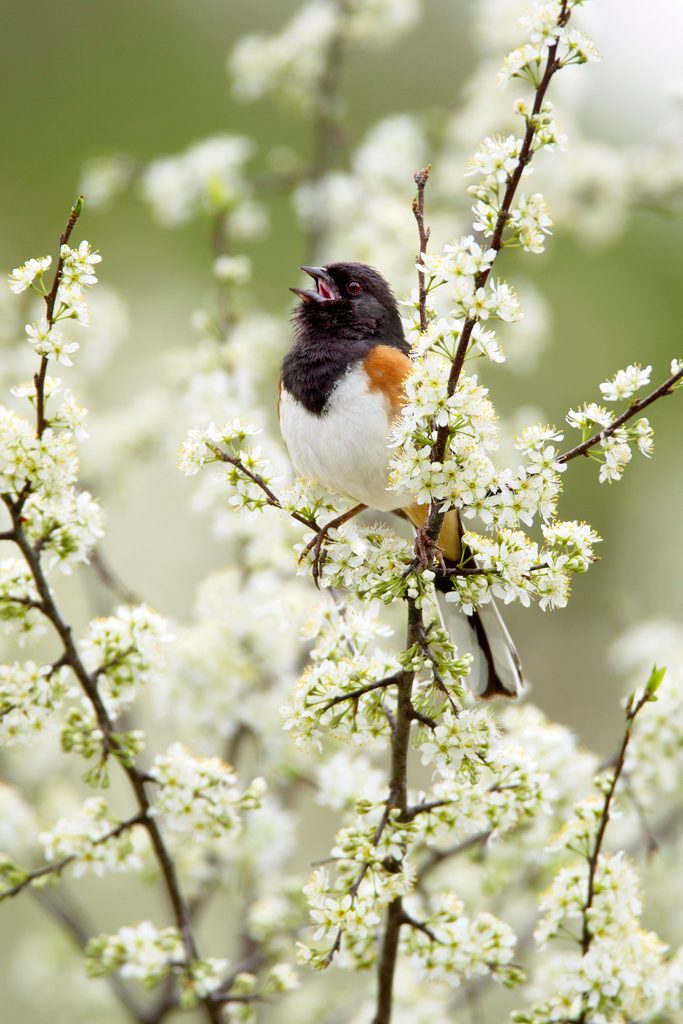
Most common backyard birds make a variety of sounds, including songs and calls. For example, the American robin song is a rich, whistled caroling—chirrup, cheerio, cheerup, cheerily—often beginning at dawn or even earlier. Robins also make many different calls, including low clucks and chuckles, sharp cries and thin lisping notes.
Songs are typically longer and more complicated than calls, and may be more musical. But the main difference is in their purpose.
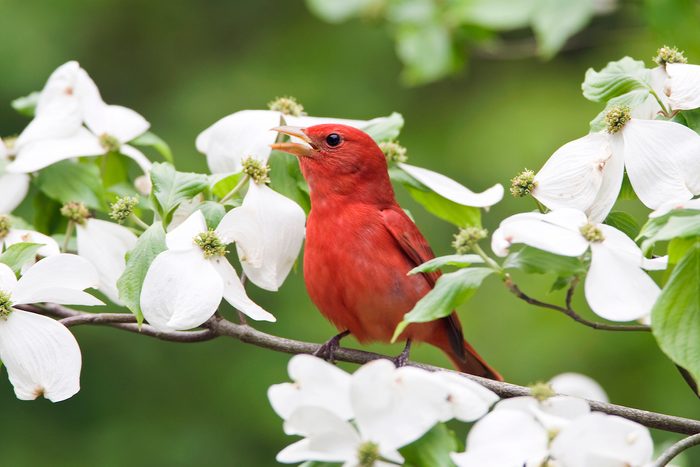
You can hear calls at any time of year, and they have a variety of functions. Harsh notes may serve as alarm calls, and the birds may have different alarm notes for various threats. Sometimes short, simple calls help members of a flock stay in contact with each other. Young birds often have food-begging calls, different from any sound made by the adults, to let their parents know when they are hungry.
Songs, on the other hand, are performed mostly by adult males, and they use them to lay claim to a nesting territory and to attract a mate—or to communicate with their mate after they have paired up. So almost all the singing is during the breeding season, and the symphony ends around the time the last brood of fledglings is ready to leave the nest. When the birds sing at other times of year, they may simply be practicing.
Learn how to identify birds by their song.
How Do Birds Learn to Sing?
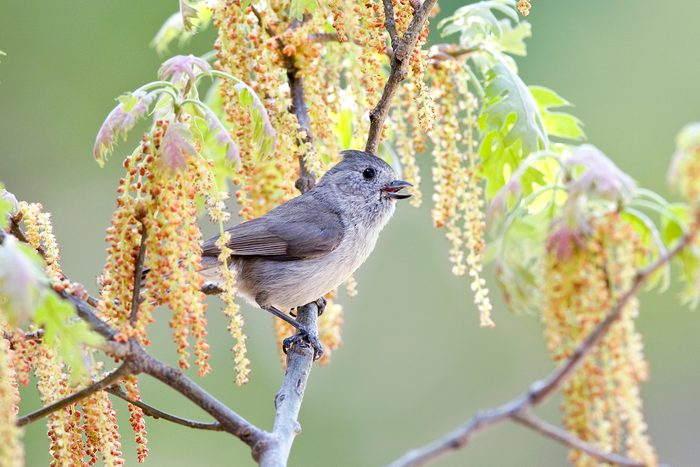
Songbirds perform so naturally that we might imagine they were born knowing their tunes, but most birds actually have to learn them. If they don’t hear their own species’ song while they are young, they will never learn to sing it properly. And because they learn to imitate the songs they hear in their home area, some species develop regional song dialects, like how humans from different places speak with varying accents.
Bird mimics and mimicry: here’s what you need to know.
White-crowned sparrows and mourning warblers are examples of birds with distinctive local dialects. But calls, unlike songs, seem to be instinctive, and birds develop the typical calls of their own species without having to hear them first.
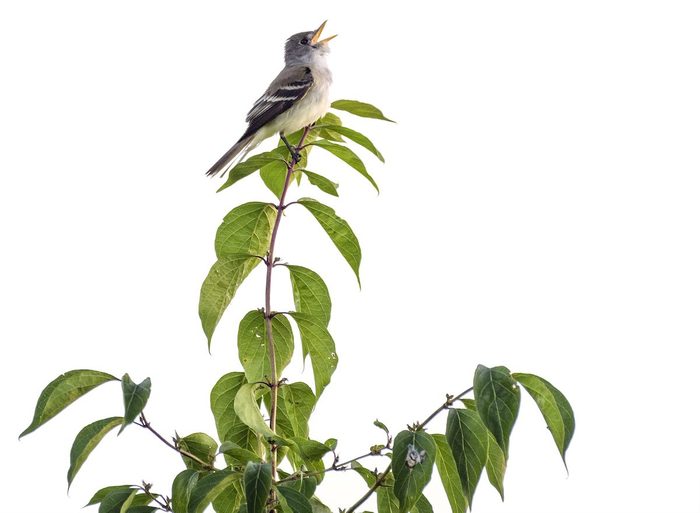
Members of the flycatcher family, such as the eastern phoebe and great crested flycatcher, differ from other songbirds because they develop their songs through instinct, not learning. And because many species of flycatchers look very similar to each other, it’s imperative for them to be able to recognize their own kind by voice.
For groups such as hawks, geese and ducks, all vocalizations are calls, not songs. And some other bird groups don’t fit in the songbird category but still make sounds that function as songs, including some hummingbirds and many nocturnal birds such as owls and whip-poor-wills, singing in the dark to defend their nesting territories. These birds are all thought to develop their sounds through instinct, not learning.
Music in motion: meet the birds that sing while flying.
Do Female Birds Sing?
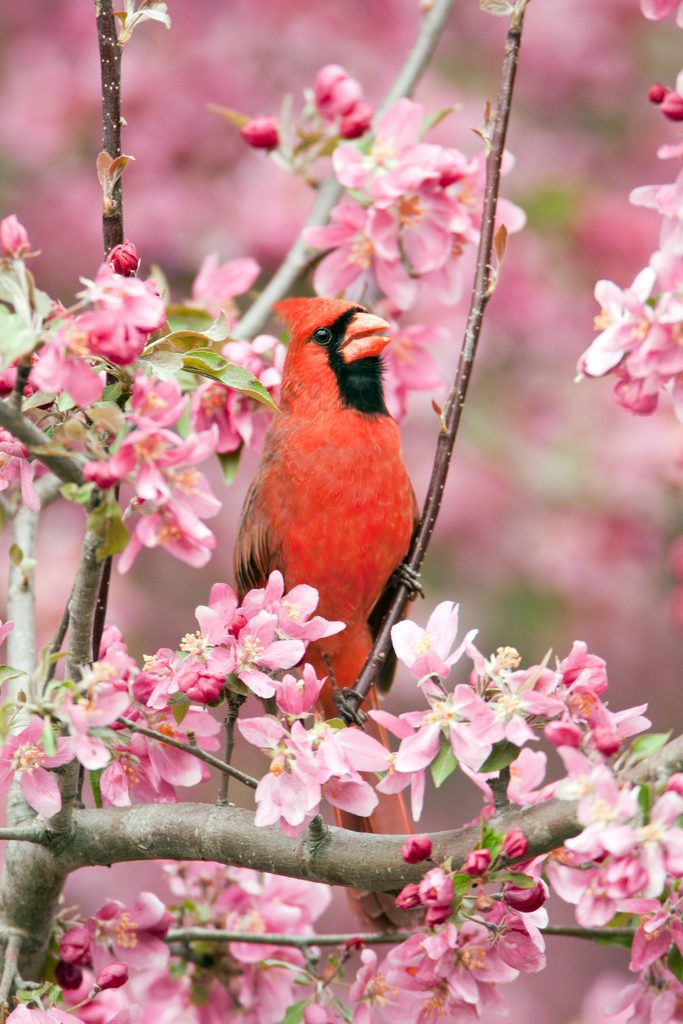
For many years, scientists assumed that males were the only important singers among birds. But recent studies have changed that view. Singing by female birds has been documented in hundreds of species now, with new examples being discovered all the time.
Female northern cardinals sing musical, whistled songs like those of the males, although not as often. In tropical forests, many female birds sing regularly, and the male and female of a pair may sing duets back and forth. Wherever you are, some birds are likely to be performing free open-air concerts nearby. Take the time to listen, and you’ll be treated to some of the most fascinating sounds in nature.
Hear the soothing sounds of a mourning dove call.
Why Do Birds Sing at Dawn?
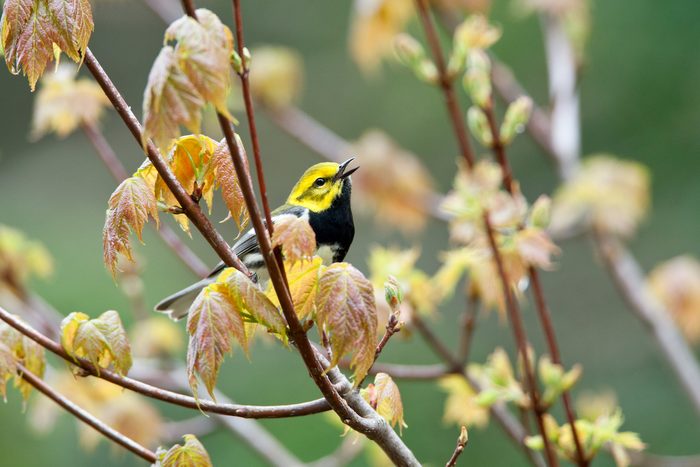
During late spring and early summer, an incentive for waking up early is the chance to hear the dawn chorus of bird songs. Some birds, such as robins and cardinals, may start singing when there is just a hint of light on the eastern horizon. More birds join in as dawn approaches, with a peak of song right around sunrise.
Why do they start so early? Birds may need to assert their claims to their nesting territory first thing in the morning, just in case any migrants have arrived during the night. And singing may be the best use of their time when it isn’t light enough yet to search for food.
Next, learn what a Baltimore oriole song sounds like.
About the Experts
Kenn and Kimberly Kaufman, authors of the Kaufman Field Guide Series, are the official birding experts for Birds & Blooms.
Why Trust Us
For nearly 30 years, Birds & Blooms, a Trusted Media Brand, has been inspiring readers to have a lifelong love of birding, gardening and nature. We are the #1 bird and garden magazine in North America and a trusted online resource for over 15 million outdoor enthusiasts annually. Our library of thousands of informative articles and how-tos has been written by trusted journalists and fact-checked by bird and garden experts for accuracy. In addition to our staff of experienced gardeners and bird-watchers, we hire individuals who have years of education and hands-on experience with birding, bird feeding, gardening, butterflies, bugs and more. Learn more about Birds & Blooms, our field editor program, and our submission guidelines.
American robins are commonly spotted (and heard) in backyards throughout most of North America. Watch for robins in your yard, no matter what the weather is like. Find out what foods robins eat and how to attract these birds throughout the year.
Learn all about robin nests and eggs.
On This Page
Do Robins Eat Bird Seed?
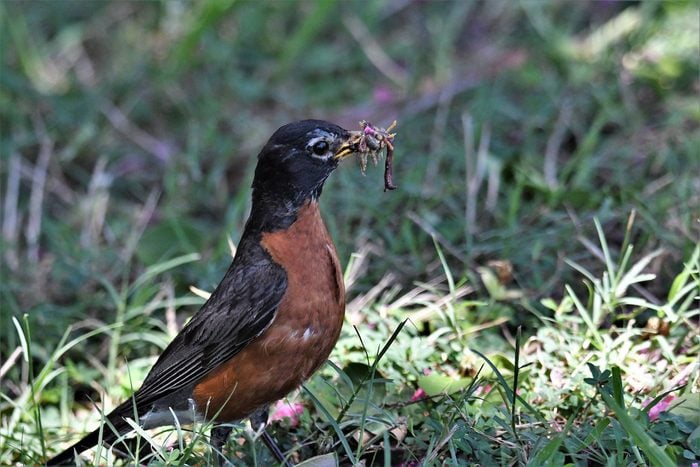
Robins are not seed eaters, so you won’t attract them with seed bird feeders. Instead, look for them on the ground. Every child knows that robins eat worms. But they also eat lots of other things, too like insects, grubs, and even snails. We tend to notice them around our gardens because they hunt for these things on the ground.
The next time you observe an American robin in your yard, notice how they curiously tilt their heads. They do this to listen for juicy worms. Robins use both visual and auditory clues to hunt down their favorite slimy snack.
Robins also eat fruit, which they search for in trees and shrubs—not where we’re used to seeing them. When winter comes, the worms and insects aren’t as available to them, so during the cold months their diet consists mostly of fruit.
What’s the difference: European robin vs American robin.
How to Feed and Attract Robins in Winter
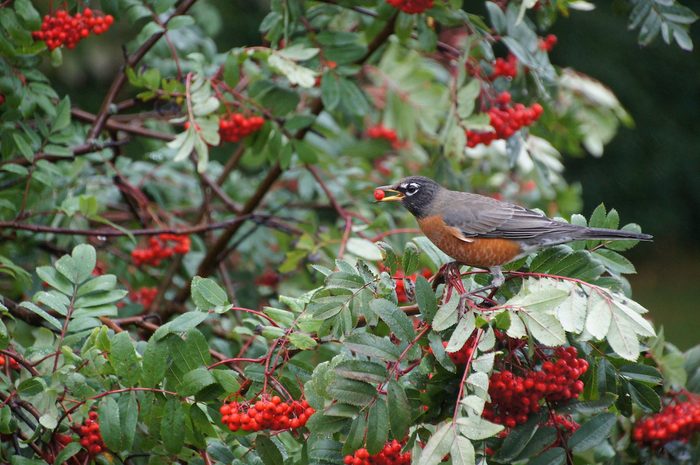
As the ground thaws and worms break through the surface, robins, members of the thrush family, become more active and visible again. But you can attract robins to your yard even when it’s snowing. In winter, flocks of robins gobble up berries from shrubs and trees. You can attract robins to your yard with trees that bear fruit in winter such as chokecherry, hawthorn and dogwood.
You can also create small piles of leaf litter around your yard to attract robins. According to the National Wildlife Federation, leaf litter is a natural habitat for insects, which in turn provides a backyard dining spot for grub and insect-eating birds such as robins.
How to Attract Robins to Feeders
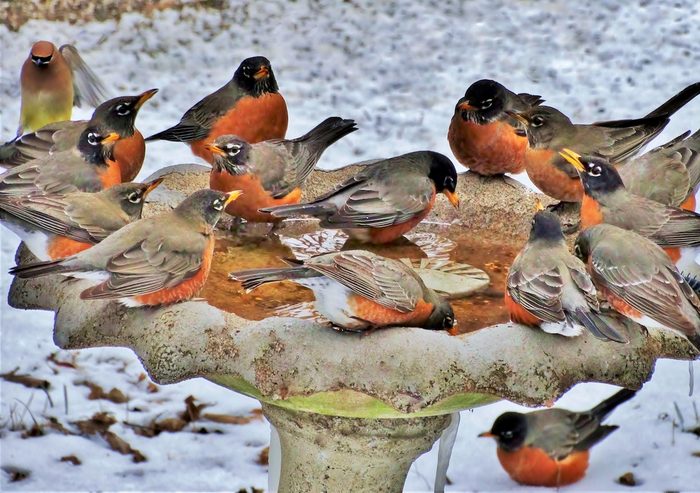
“A flock of robins stayed with us last winter and ate all the berries growing in our area. How can we attract them to feeders?” asks Birds & Blooms reader Susan Petrch of Millbrook, Ontario.
Birding experts Kenn and Kimberly Kaufman say, “Robins aren’t typical feeder guests, but there are some things you can try. It’s best to place an open tray feeder near one of the berry-producing trees frequented by the robins and stock it with raisins, apple slices or other fruit. You can also offer mealworms or suet.
But it’s normal for flocks of robins to be nomadic in winter, wandering long distances and stopping when they find a natural food source. Once they’ve depleted the local berry supply, most likely they’ll be off in search of the next berry crop instead of sticking around at feeders.”
Did you know: Robins also visit bird baths for fresh water. You can offer a heated bird bath in the winter to bring these birds to your yard.
Enjoy cheerful robin bird pictures to welcome spring.
Do Robins Eat Suet?
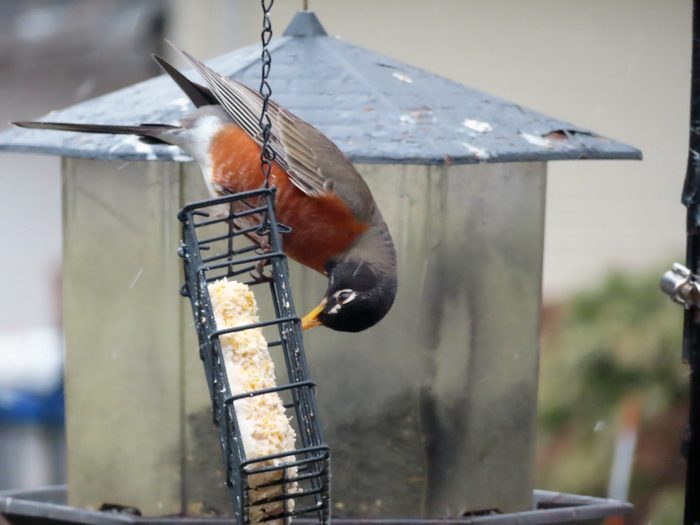
“Is it uncommon for robins to like suet? I’ve had one visiting my feeder twice a day,” asks reader William Toth of Mechanicsburg, Pennsylvania.
Kenn and Kimberly say, “Although people tend to think of robins as strictly worm eaters, they actually have quite a varied diet. Wild fruits and berries make up a big part of their diet, especially in fall and winter, when worms are much harder to come by. Robins are not commonly attracted to feeders, but sometimes an individual will key in on a feeder offering mealworms, raisins, suet or even grape jelly, and will start visiting it regularly.”
Next, find out if robin sightings have special meaning.
Additional reporting by Kirsten Schrader
About the Experts
Kenn and Kimberly Kaufman, authors of the Kaufman Field Guide series, are the official birding experts for Birds & Blooms.
Sources
Why Trust Us
For nearly 30 years, Birds & Blooms, a Trusted Media Brand, has been inspiring readers to have a lifelong love of birding, gardening and nature. We are the #1 bird and garden magazine in North America and a trusted online resource for over 15 million outdoor enthusiasts annually. Our library of thousands of informative articles and how-tos has been written by trusted journalists and fact-checked by bird and garden experts for accuracy. In addition to our staff of experienced gardeners and bird-watchers, we hire individuals who have years of education and hands-on experience with birding, bird feeding, gardening, butterflies, bugs and more. Learn more about Birds & Blooms, our field editor program, and our submission guidelines.
On This Page
Why Groundhogs Are a Problem in the Garden
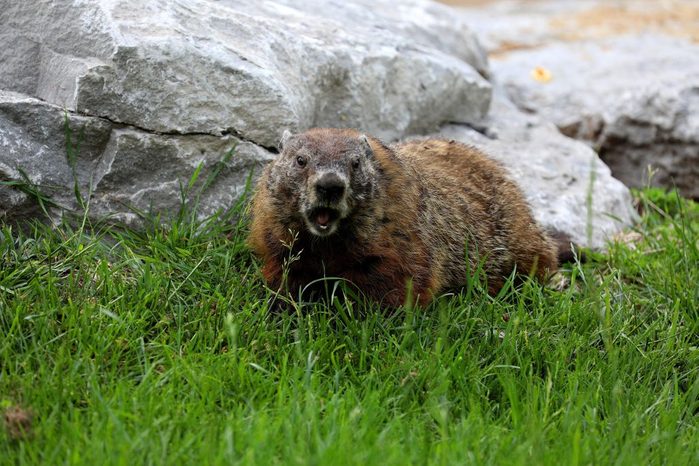
Perhaps most famous for having a February holiday named after them, groundhogs are furry mammals that can be found across much of the eastern and central U.S. and up into Canada. Groundhogs create deep underground burrows, some of which stretch for more than 20 feet. These rodents aren’t particularly picky eaters, happily snacking on a wide range of vegetation including grasses, bark, flowers and berries.
Did you know: Whether you prefer to call them groundhogs or woodchucks, it’s perfectly fine to call these animals either name.
The problem comes when they move into backyards and start devouring your garden plants. Groundhogs like to pack on pounds during warmer months to gear up for hibernation, which typically starts in mid-fall.
Read on for expert and home gardeners’ advice on how to keep groundhogs out of your garden.
Will Gopher Spurge Deter Groundhogs?
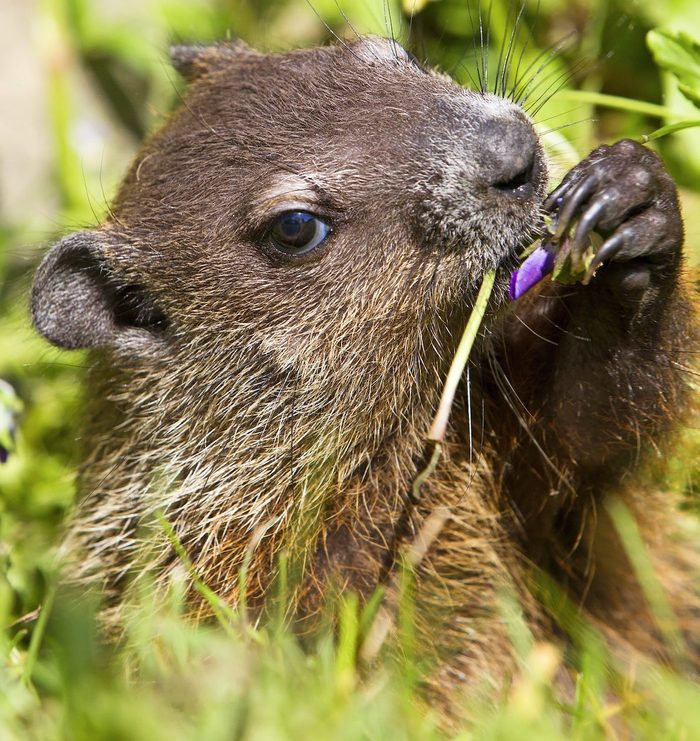
Birds & Blooms reader Linda Hall of Aurora, Indiana, asks: “A groundhog loves eating my mums. Can I plant something nearby to discourage it?”
“Unfortunately, no plants can actually deter groundhogs from eating flowers or shrubs,” says gardening expert Melinda Myers. “You may have heard rumors that gopher spurge (Euphorbia lathyris) repels gophers and moles. This hasn’t been proven to be true. This spurge is very aggressive, reseeds readily and is considered invasive in a few states.”
Use Fencing to Keep Groundhogs Out of Gardens
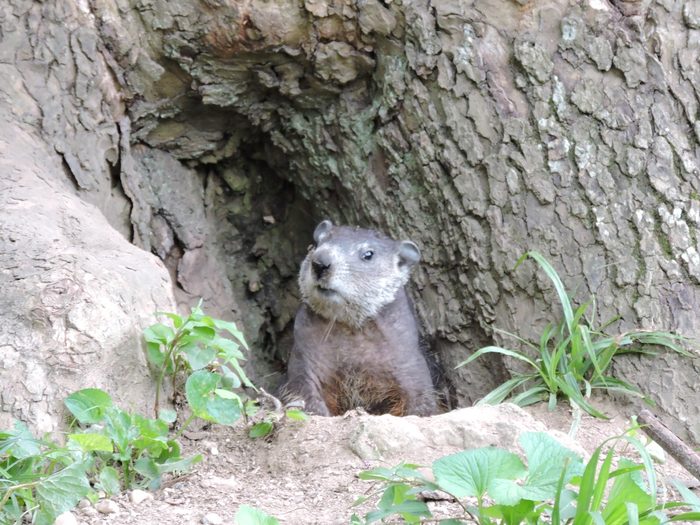
Melinda points out that using fencing to deter groundhogs is challenging. They are extremely versatile and can both climb and burrow. Bury the bottom of a fence at least a foot deep or bend the bottom foot of fencing at a 90-degree angle and pin it to the ground. The fence needs to be 3 feet high, with the top 12 to 15 inches bent outward at a 45-degree angle to help keep groundhogs from climbing it.
An electric fence mounted on posts with strands 4 inches and 9 inches above the ground is another option that is probably more effective. Look for electric fences at garden centers or online.
Reader Ideas to Deter Groundhogs and Chipmunks
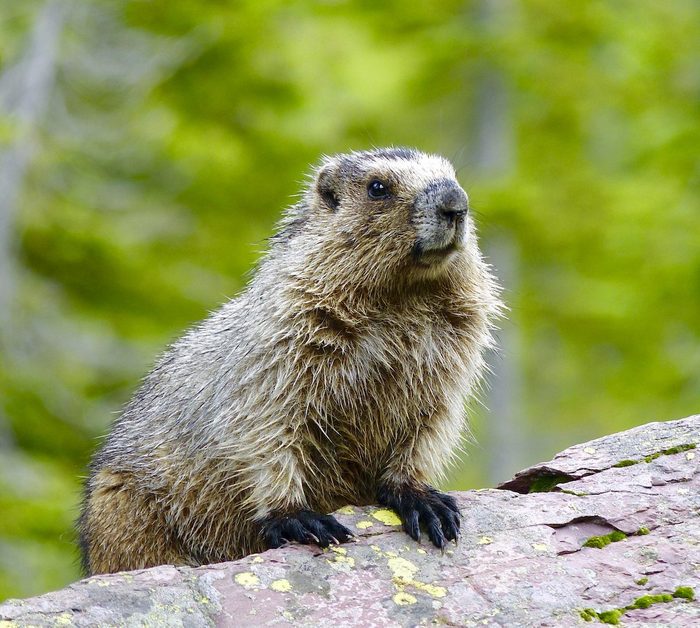
Home gardeners share their favorite techniques for keeping groundhogs and chipmunks out.
- I try to find the groundhog’s home (usually under my shed or deck) and have used a flood light and music as a deterrent under the deck. I’m not sure which worked, but the groundhog and its family left, says Field Editor Boni Trombetta of West Chester, Pennsylvania.
- To keep chipmunks from eating the roots of my potted plants, I put small flat stones on top of the soil, says Monica Partington of Raleigh, North Carolina.
- Vinegar can help keep away critters. You have to apply it often enough that the scent stays detectable by humans (and therefore stronger to the animals), says Field Editor Kathryn Rucci of Orlando, Florida.
- I scatter my husband’s hair around the garden after giving him a cut, says Char Jasinski of New Berlin, Wisconsin.
- To prevent them from eating my lettuce, carrot tops, beet greens and more, I make hoops and cover them with bird netting. They get the hint, says Field Editor Sue Gronholz of Beaver Dam, Wisconsin.
Why Trust Us
For nearly 30 years, Birds & Blooms, a Trusted Media Brand, has been inspiring readers to have a lifelong love of birding, gardening and nature. We are the #1 bird and garden magazine in North America and a trusted online resource for over 15 million outdoor enthusiasts annually. Our library of thousands of informative articles and how-tos has been written by trusted journalists and fact-checked by bird and garden experts for accuracy. In addition to our staff of experienced gardeners and bird-watchers, we hire individuals who have years of education and hands-on experience with birding, bird feeding, gardening, butterflies, bugs and more. Learn more about Birds & Blooms, our field editor program, and our submission guidelines.
Sources
- North Carolina State Extension
- Melinda Myers, official gardening expert for Birds & Blooms
